The post Web of Make believe: Death, Lies and the Internet – Netflix Review appeared first on Heaven of Horror.
Ronald.phillips
Shared posts
Web of Make believe: Death, Lies and the Internet – Netflix Review
Malware's Destruction Trajectory and How to Defeat It
Malware and targeted attacks on operating systems and firmware have become increasingly destructive in nature, and these more nefarious attack methods are rising in prevalence. And just to add insult to injury, there are more of them. Today’s attacks are hitting more often, and they are hitting harder.
GitLab Now The Main Development Platform For Wine
Blizzard claims it won't monetize 'Diablo IV' like 'Diablo Immortal'
Diablo IV will feature a different set of monetization systems than those found in Diablo Immortal, according to Blizzard. “To be clear, D4 is a full-price game built for PC/PS/Xbox audiences,” said Diablo franchise general manager Rod Fergusson following the game’s latest showing during Microsoft’s Summer Game Fest presentation on Sunday. “We are committed to delivering an incredible breadth of content after launch, for years to come, anchored around optional cosmetic items and full story-driven expansions.”
To be clear, D4 is a full price game built for PC/PS/Xbox audiences. We are committed to delivering an incredible breadth of content after launch, for years to come, anchored around optional cosmetic items & full story driven expansions. More details soon. Necro blog tomorrow!
— Rod Fergusson (@RodFergusson) June 12, 2022
Blizzard has similarly promised to support the recently released Immortal for a while but is doing so through an in-game marketplace where players can purchase optional cosmetics, an “empowered” battle pass and “eternal orbs,” a premium currency that can be exchanged for the game’s controversial “legendary” crests. The consensus among the gaming community is that Immortal features some of the most aggressive and predatory monetization systems found in a Blizzard game to date. One estimate suggests it would take someone 10 years or $110,000 to acquire enough “legendary gems” to equip their character with the best possible gear. Since the release of Immortal, Diablo fans have been worried that Blizzard would employ a similar set of monetization systems in Diablo 4 when that game comes out in 2023.
However, Fergusson’s statement suggests Diablo IV will be closer to Diablo III than Immortal. The former did not feature microtransactions – though it launched with a controversial in-game auction house – and Blizzard went on to support the title with a $40 expansion in 2014 and a $15 DLC in 2017 that added Diablo 2’s necromancer class to the game. Still, reading through Fergusson’s Twitter replies, you see a lot of fans expressing concern that even the mention of cosmetics could imply more microtransactions than Blizzard is suggesting. Neither Fergusson nor Diablo community lead Adam Fletcher mentioned a paid battle pass, but that’s one way Blizzard could make some cosmetics obtainable since many games, including Immortal, incorporate them as a completion reward.
Lightyear Review: The Toy Story Spin-Off Boldly Goes Where Many A Sci-Fi Movie Has Gone Before

How does one go beyond (pardon the pun) the masterful "Toy Story" movies? The original 1995 film put Pixar on the map as not just a pioneer of CG animation, but as a hub for thoughtful, high-concept, character-driven storytelling. All of the following "Toy Story" movies would only strengthen that reputation for Pixar, bringing the series to new emotional, weepy heights. But now that the story of Andy and his lovable band of misfit toys has come to an end, there's only one direction that the "Toy Story" franchise can go: the stars.
"Lightyear" is a spin-off of sorts to the "Toy Story" movies, a sci-fi epic that follows the adventures of the human Buzz Lightyear that the toy is based on. Only it isn't really — this is a movie within the universe of "Toy Story," the blockbuster that, as the opening text reveals, would become a young Andy's favorite movie and inspire him to buy the Buzz Lightyear toy. But herein lies the first hiccup in the film's internal logic: "Lightyear" is an ambitious sci-fi throwback to pulpy adventures and speculative fiction that riffs on "Star Trek" and "2001: A Space Odyssey" (the "Star Trek" energy is especially potent) — but no child in 1995 would name it their favorite movie. (The short-lived and extremely fun ABC/UPN TV series "Buzz Lightyear of Star Command," on the other hand, Andy and co. would've gobbled up.)
To put it simply, this is a movie for "Toy Story" adults — the people who grew up on the movies and now hold jobs and mortgages — not "Toy Story" children. And while that's perfectly fine (good, even!) it does start the movie off on a strange foot; the film's wrestling with legacy, the passage of time, and the fallacy of rugged individualism all land a little softer as you ponder: who is this for?
Shoot For The Stars, Land On The Roof

The cynical answer is that "Lightyear" is for the movie buffs who grew up on "Toy Story" and want to see their favorite childhood characters act out their favorite sci-fi movies. The less cynical answer is that it's an opportunity for a budding filmmaker (Angus MacLane, making his directorial debut after years as an animator at Pixar) to show off his talents by making the sci-fi epic he has long aspired to make, nestled here within the cozy confines of an established franchise. The truth is that it's probably something in between the two — an ambitious riff on sci-fi classics that goes down a little easier in the capable hands of Pixar.
Chris Evans (doing a clipped, staccato delivery straight out of a William Shatner performance that only solidifies the "Star Trek" parallels) stars as Buzz Lightyear, a legendary Space Ranger whose one critical mistake results in his team getting stranded on a hostile alien planet 4.2 million light-years away from Earth. With their only means of returning home to Earth, a hyper-speed crystal that is extremely dangerous to engineer, destroyed, the crew of 1,000 decide to make the best of their situation and settle down on the planet — all except for Buzz. Wracked with guilt over his failure, Buzz throws himself into the task of testing out a new hyper-speed crystal that can bring them all back home. But the first test flight results in a time dilation: a four-minute test flight for Buzz is four years on the planet for everyone else.
That includes his friend and fellow Space Ranger Alisha Hawthorne (Uzo Aduba), who remains his most passionate supporter even as she settles down with the rest of the colony — finding a wife, having a child, growing old and content as Buzz stays the same, obsessed with testing out the crystal and "finishing the mission." Buzz gets so carried away with this mission that, before he knows it, decades have passed and Alisha and his former teammates are long dead. The planet he lands back on is now overrun by killer alien robots, with a scrappy team of junior cadets led by Alisha's spunky granddaughter Izzy (Keke Palmer, having a blast) and including the cowardly Mo (Taika Waititi, playing a very Waititi character) and wild-card felon Darby (Dale Soules, all gruff steel), his only hope for saving the colony.
All That And A Robot Cat

A man's debilitating obsession with "greatness" and legacy is the stuff that great filmmakers and great writers have long chewed on, and it gives "Lightyear" the kind of emotional depth that we've come to expect from a Pixar movie. The only thing is that it's nothing new: better sci-fi films such as "Ad Astra" have tread this space before. And, to an extent, so has the first "Toy Story" movie — in a way, the real Buzz Lightyear goes through effectively the same character arc as the toy Buzz does: getting his ego deflated and realizing the error of his lone-wolf ways, all in favor of embracing a new found family in all their flaws.
It's kind of funny that we get two versions of this arc, especially since the toy Buzz in "Toy Story" was created to lampoon the kind of hypermasculine heroes that were popular in '90s blockbusters — again, an internal logic discrepancy: why is toy Buzz on such an ego trip if his source material isn't like that at all?
In the end, it doesn't matter, because "Lightyear" is a perfectly fun time. The ensemble is wacky and lovable, and the robot cat that Buzz is gifted by Alisha, Sox (voiced by Peter Sohn), is a surprising MVP of the movie — avoiding any potentially annoying pitfalls of such a gimmicky character by virtue of being freaking hilarious.
"Lightyear" may not reach the heights of the great sci-fi movies that it pays tribute to, or even the "Toy Story" movies themselves. But it's a visually impressive, escapist riff on the sci-fi epic that, at the very least, might become the favorite movie of some kid, somewhere.
/Film Rating: 7 out of 10
Read this next: The 14 Best Animated Movies (That Aren't Made By Disney Or Pixar)
The post Lightyear Review: The Toy Story Spin-Off Boldly Goes Where Many a Sci-Fi Movie Has Gone Before appeared first on /Film.
You Can Now Stream The Bonkers Natasha Lyonne Horror Movie The World Wasn't Ready For

When we talk about "lost films," we typically think of movies that were made decades before the technology existed to keep them preserved, or films that never made the jump from one medium to another, cemented forever on VHS tapes and illegal rips to YouTube. More than likely, you're not going to think of a film with a leading performance by the star of "Russian Doll," "Orange Is the New Black," an upcoming murder-mystery series from Rian Johnson, and the woman who hosted "SNL" on the final night of Kate McKinnon, Pete Davidson, Aidy Bryant, and Kyle Mooney. And yet, that's exactly what almost happened with Joshua Grannell's "All About Evil," starring the one, the only, Natasha Lyonne.
"All About Evil" tells the story of Lyonne as a meek and mousy librarian named Deborah who inherits an old-school movie theater after her father passes. Deborah's ruthless and abusive stepmother tries to convince Deborah to sell the theater as a means to collect the cash, which sends Deborah on a murderous killing spree making grisly short films to play at the theater, with the audience unaware that they're actually witnessing Deborah's homemade snuff films.
The film debuted at the San Francisco International Film Festival and enjoyed a limited theatrical run with a touring production throughout 2010. And then ... that was it. No huge release. No Netflix deal. It's as if the film disappeared into the ether, becoming the ultimate underground midnight movie, remembered only by those fortunate enough to have witnessed it. Now, thanks to a brand new blu-ray release from Severin Films and the horror hounds over at Shudder, "All About Evil" is finally available for consumption by the masses.
A Film From A World We Forget Existed
If you don't know the director Joshua Grannell by name, you may be more familiar with his drag persona, Peaches Christ. A staple of both the San Francisco drag and movie scene, Peaches Christ hosted the Midnight Mass movie series for over a decade, and now hosts a podcast of the same name with frequent collaborator Michael Varrati, celebrating the cult films frequently shown during Peaches' series. When it comes to the world of midnight movies, Peaches Christ is the queen of the midnight movie scene, and a bonafide cult leader ... of cult classic cinema, of course. "For years, the movie has been unavailable and fans have been clamoring for it," Peaches said in a statement. "As the creator, it's been frustrating to say the least."
When "All About Evil" debuted in 2010, the world was a lot different than it is today, despite it feeling for some like just yesterday. For perspective, "RuPaul's Drag Race," which has earned host RuPaul Charles the distinction of winning the most Emmy Awards for a person of color, premiered its first season just the year prior, events like DragCon wouldn't exist for another five years, "The Boulet Brothers' Dragula" was still an underground showcase without television cameras, and the legalization of gay marriage in the United States was still half a decade away. A low-budget horror movie starring mostly underground stars and directed by a drag queen wasn't going to be viewed as a hot commodity in 2010 the way it is now. But Peaches Christ has been putting in the work for decades, even if the world at large didn't appreciate it.
All The Makings Of A Midnight Movie Classic

"All About Evil" has all of the staples of a midnight movie classic, thanks to a script and directorial eye fostered by Grannell's years of presenting, appreciating, and preaching the gospel of films often relegated to rowdy, after-hours crowds. "I feel like I've been given a great gift from both Severin and Shudder and am thrilled so many new people will discover my Evil little baby," Grannell said. If the mysterious history of the film doesn't intrigue you enough, perhaps the dynamic cast will. In addition to Lyonne starring as Deborah, "All About Evil" also features Thomas Dekker ("Terminator: The Sarah Connor Chronicles," "Kaboom"), Cassandra Peterson (Elvira: Mistress of the Dark), Mink Stole ("Pink Flamingos," "Female Trouble"), Noah Segan ("Looper," "Knives Out"), Ashley Fink ("Glee"), Patrick Bristow ("Showgirls"), Jack Donner ("Star Trek: Enterprise"), Julie Caitlin Brown ("Babylon 5") and twin stars, Jade and Nikita Ramsey.
With a title making a clear play on the classic "All About Eve," the references and homages played throughout "All About Evil" range from the days of black and white horror to the extreme horror boom of the aughts, serving as the ultimate Easter egg hunt for fans of the midnight macabre. It's a shame that it's taken 12-years for the film to rightfully be given its place in the sun, the cinematic world is better for now having access. The world wasn't ready for "All About Evil" in 2010, but now, it's time to play catch-up or risk becoming Deborah's finest fatal frame.
Read this next: /Film's Top 10 Movies Of 2021
The post You Can Now Stream the Bonkers Natasha Lyonne Horror Movie The World Wasn't Ready For appeared first on /Film.
Everyone Wants Brian Cox To Say His Succession Catchphrase ... And It Can Get Awkward

Each new day brings about another dystopian development of disgustingly rich white folks using their conglomerate power to spread misinformation and further descend us into the hellscape we seem to be living in, and yet it's difficult to resist the allure of "Succession."
The HBO drama exists as this kind of outlier wherein this contemptible family, whom I normally wouldn't be able to bear under any other circumstance, transcends their brand into becoming one of the most scathing critiques of unchecked power. And yet, week after week, the Adam McKay-produced series somehow finds a way to make me feel slightly sorry for the Roys, especially the children.
"Succession" is, ultimately, a hilarious Shakespearean tragedy about three children whose entire lives are affected by the means of their neglectful and abusive father Logan Roy, whether they're in his favor or pushing against him. For better or worse, he has molded them into a corporate world that they want a more active part in, but have little chances of ever reaping the benefits. It's not enough that Logan actively discards them once he's used them up. He's a con man and a generally awful human being. It just so happens that this captivating television monster is played by none other than Brian Cox, who knows his way around breaking you down with his words. Just be careful where you ask him to do it.
Getting The Logan Roy Experience

When Logan is dissatisfied with you, he's the kind of person that looks into your soul and emits a hearty "f*** off" with the potency of a beast. He's got one for every occasion, whether he's reached his breaking point, he's bored, or simply annoyed by you. With any other person, you'd feel insulted, but getting the opportunity of Cox yelling that at you sounds like a dream. Although that could come with some complications.
While participating in a roundtable for The Hollywood Reporter, Cox recalls an incident where a fan request happened to be a serious case of "wrong place, wrong time:"
"Well, it's not the easiest thing to say to people. I mean, it started when I was playing L.B.J. in one of those theaters in New York. I came out one night and there was this young couple, very sweet, about 17, and they had a video and they said, "Could you tell us to f*** off, please?" I mean, it's unbelievable. But the worst was here in L.A. when I went to a meeting for Ronan Farrow, a #MeToo thing. He was launching the book and all these Hollywood women were there and it was very intense. And I was standing at the back and then [the women] all turned around and saw me and they [pointed a] camera and said, "Can you tell us to f*** off?" I was like, "This is a #MeToo meeting, is this really proper to be asking me to tell you to f*** off?"...(Laughter.)"
The optics of pulling the "Succession" catchphrase at this event probably wouldn't look all too great for Cox, but that has less to do with him, and more to do with the subjective nature of it through outside ears.
Catchphrase Or Insult?
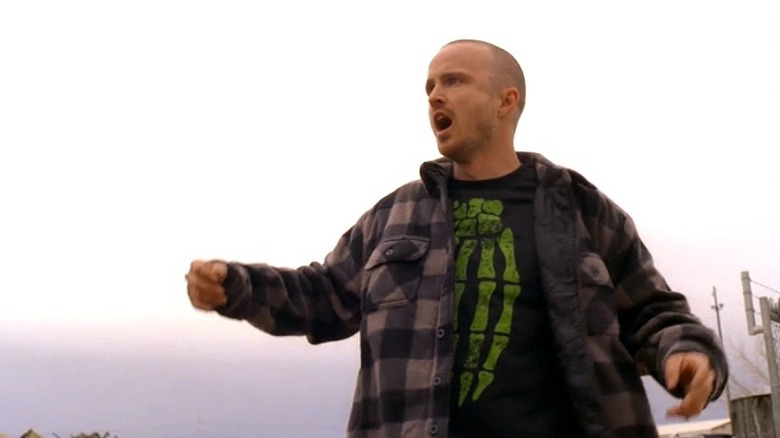
Actors repeating the catchphrases that made them famous is a time-honored tradition. You wouldn't bat an eye at Bruce Campbell ("The Evil Dead") calling someone "groovy," or Jim Parsons ("The Big Bang Theory") pulling a "Bazinga" (although that would admittedly startle me). Both lines are directly linked to these actors, and can't be mistaken. When it comes to insult catchphrases, however, that's where things get a little murky.
"F*** off" is the kind of phrase you stand the chance of hearing every day, but it sounds so good to hear it come out of Cox's mouth. It's the reason why people want Gordon Ramsey to roast their homemade dishes with his brand of colorful language. It's also the Jesse Pinkman (Aaron Paul) dilemma where using your catchphrase to the general public could go really wrong if outside parties aren't in on the joke, especially since his "Breaking Bad" is infamous for incorporating "b****" into as many conversations as he can.
Cox, meanwhile, is kind of burdened with a line that anyone not in the "Succession" loop would think of as the "Manhunter" actor actually yelling at them. I guess that's what happens when something associated with your character is way too universal.
"Succession" Seasons 1-3 are now available to stream on HBO Max.
Read this next: The 18 Best Crime Dramas In TV History
The post Everyone Wants Brian Cox to Say His Succession Catchphrase ... and It Can Get Awkward appeared first on /Film.
Turns out those free Resident Evil 2, 3, and 7 next-gen updates are available right now

Thanks, Capcom
Resident Evil has one of the most loyal fanbases out there, and those who love the series have been looking forward to playing their favorite games of the series on next-gen consoles. Earlier this year, Capcom announced that they'd be able to do just that, because they had free updates for Resident Evil 2, 3, and 7 in the works for PS5, Xbox Series X/S, and PC.

During today's Capcom Showcase as part of the summer news blitz, they let us know that actually, these updated versions are available instantly. That was a nice surprise! The Xbox update will even be available with Xbox Smart Delivery, making it even easier for players to update to the best version for their console.
As reported a few months ago, the updated versions mostly just give us nicer graphics for each of the titles. It's nice that a company would go out of their way to make sure their games look amazing, free of charge. Now go and download your free update!
https://www.youtube.com/watch?v=ro2AussKF4w
The post Turns out those free Resident Evil 2, 3, and 7 next-gen updates are available right now appeared first on Destructoid.
The Terrifying Florence Pugh Scene That Still Gives Us Nightmares

In Ari Aster's hypnotic 2019 film "Midsommar," a group of anthropology students visits a remote Swedish commune, where a series of ritualistic horrors unfold in the harsh light of day. The group includes Florence Pugh's Dani, a grief-numbed young woman whose family just died via a gruesome murder-suicide. Strange, dark, and even funny, "Midsommar" follows Dani's surprisingly healing journey into a culture that confronts death head-on.
The movie is filled with unnerving imagery and sequences that purposely disorient, as Aster applies the same freaky horror sensibilities he employed in "Hereditary" a year earlier. Only, while "Hereditary" wove its most disturbing moments into the shadows of night, "Midsommar" ratchets up the tension in the deceptively safe summer sunlight.
One scene, more than any other, propels the group's trip from an uncomfortable vacation to a full-blown nightmare. It also pushes "Midsommar" into straight horror territory. The scene takes place on the group's second day among the Hårga, the cult-like clan of Swedes whom these students are observing for an anthropology project. Dani is recovering from a bad drug trip, and when she joins the group of white-clad locals planted at the bottom of a steep cliff, the camera has a bleary, slightly psychedelic focus.
Dani snaps to attention, though, when she realizes what's about to happen. An old woman (Katarina Weidhagen) stands at the top of the cliff, and as she starts to lurch forwards, Dani grabs her boyfriend's arm with a heaving gasp. Before she can act, the woman steps off the edge, launching herself into a very public and gory death. From that moment on, Aster shoots the sequence from the perspective of Dani's dazed shock. The camera blurs in and out of focus, while the exclamations of her fellow travelers are muffled and contrasted with a droning score.
The Ritual Of Ättestupa

This scene in "Midsommar" pulls from the folkloric idea of the Ättestupa, a legendary ritual through which Scandinavian elders may or may not have thrown themselves from cliffs in historic times. "This isn't being pulled from historical fact," Aster explained in an interview with GQ, "but it is part of Swedish folklore that people once committed ritual suicide this way, with an audience present."
The scene only gets more nightmarish when a second person jumps. This time, it's an elderly man (Björn Andrésen), and his choking gasps cut through the haze of Dani's shock as he lays with one leg twisted and demolished beneath him. Astonishingly, a group of figures puts the man out of his misery by bludgeoning him with a cudgel in a slow, ceremonial fashion.
Plenty of horror scenes are scary in a way that doesn't linger, but this moment from "Midsommar" has stuck with audiences years later thanks to its perfectly destabilizing design as well as Pugh's shell-shocked performance. On a technical level, the scene pulls off some truly gross imagery, as viewers -- like the surrounding crowd -- are exposed to the pulpy skulls and torn-up limbs of the elders.
According to Vulture, the sickening shots were created with some impressive practical effects. For shots of Andrésen's mangled body, the crew put the actor in a hole in the ground with only his head sticking out, then connected it to a broken and mangled dummy body. For the bloody head, the team constructed a complex skull featuring pneumatic cylinders that could collapse in on itself and spurt prop blood. Meanwhile, makeup artist Iván Pohárnok and his team painstakingly created realistic human remains by 3D printing digital scans of actors and adding elements like hair by hand.
Aster And Pugh Leave Audiences Shell-Shocked

As frightening as the stomach-churning imagery in the Ättestupa scene may be, it works largely because of Pugh's performance as Dani. Even as she reacts to the carnage, Dani seems rooted in place, held there by some power beyond herself. "You're dealing with the logic of why people don't leave when something horrible happens," Aster tells GQ, and Dani has plenty of reasons to stay despite herself. She's an anthropology student, for one thing, and understands that one culture's nightmarish scenario might be another's highest show of respect. She's also stunned by her grief and is still coming down from a hallucinogenic trip, plus she seems drawn into the traditions of the Hårga in an almost predestined way.
We don't see Dani emote much until the film's last moments, when she breaks into a world-flattening scream of catharsis while surrounded by worshipful Hårga. This early in the film, though, Pugh plays her like someone who's too disoriented to control much beyond her own frantic breathing. "It's almost as though after that first impact, she's watching everything from underwater," Aster explained to GQ, adding that Pugh understood the feeling of the scene without much direction. "The moment after the first woman jumps, where it's almost like the dust is knocked off of Dani and she's punched into another reality and just kind of dissociates completely."
By putting audiences through the wringer with this grotesque scene, horror master in-the-making Aster forces "Midsommar" viewers to see the world through Dani's eyes. Only, when the climax comes, the folks watching along can't exactly scream along with her. Instead, they're forced to leave the movie with the feeling of having witnessed a disaster unfolding in slow motion, unable to move or stop it, just like Dani at the bottom of the cliffs.
Read this next: The 31 Scariest Movie Scenes Ever
The post The Terrifying Florence Pugh Scene That Still Gives Us Nightmares appeared first on /Film.
Resident Evil 2, 3, and 7 “Next-Gen” Updates Available Today and Look Nice in a New Trailer

Earlier this year, next/current-gen updates for Resident Evil 2, 3, and 7 were promised, and today during the Capcom Showcase it was announced that they're releasing... today! We also got a new trailer showing the upgraded titles in action. It looks like Capcom has put a solid amount of work into these upgrades, serving up boosted resolution, framerates, and new features like ray tracing. Best of all, these updates are free for those who already own the Xbox One, PS4, or PC versions of the games, with save files transferring over. You can check out the trailers for the updated versions of RE2, 3, and 7, below.
Resident Evil 2, 3, and 7 were some of the underrated best-looking games of the past generation, so I'm eager to check them out with a new layer of polish! Need to know more? Here's a bit more official detail courtesy of Capcom...
Oh, and one more thing. Resident Evil 2, Resident Evil 3, and Resident Evil 7 biohazard reanimate today on PlayStation 5 and Xbox Series X|S with 4K resolution, ray tracing, high frame rate, and 3D audio. DualSense haptic feedback and adaptive trigger support are also available on PlayStation 5. PlayStation 4 and Xbox One players can upgrade at no additional cost via the digital upgrade program and Smart Delivery. These upgrades will also be available today on PC via a patch.
It would be nice to know exactly what kind of visual modes will be available with these updates, as well as a bit more detail on how exactly ray tracing is being implemented. That said, I'm sure we'll have full breakdowns soon enough now that these updates are out in the wild.
The Resident Evil 2, Resident Evil 3, and Resident Evil 7 next-gen updates are available now on PC, Xbox Series X/S, and PS5. What do you think? Anybody out there planning to revisit some recent RE favorites this evening?
The post Resident Evil 2, 3, and 7 “Next-Gen” Updates Available Today and Look Nice in a New Trailer by Nathan Birch appeared first on Wccftech.
PlayStation Takes On Xbox With New Subscription Service
Read more of this story at Slashdot.
5 Brilliant Philip Baker Hall Movies And Where You Can Watch Them

Actor Philip Baker Hall was masterful at creating characters that were simultaneously gruff and wounded. Many of his characters read as sad, and often relatably pathetic. No matter how young he was in a role, he could communicate that his character has led a long, interesting life.
Hall's film career began in 1970 with an appearance in the counterculture satire "Cowards" (aka "Love-In '72" when it was covertly reissued) about draft dodgers during the Vietnam War. Hall made his first big splash in 1984 with the release of Robert Altman's "Secret Honor," a one-man show wherein Hall played Richard Nixon, alone in his New Jersey mansion. The film is an extended monologue and may be Hall's greatest performance.
Hall would pop up in a few '80s blockbusters ("Midnight Run," "Ghostbusters II") and a few '90s thrillers ("Eye for an Eye," "Kiss of Death") before finding a new career groove with then-rising director Paul Thomas Anderson. In Anderson's 1996 feature debut "Hard Eight," Hall would play a mysterious perhaps-criminal gambler named Sydney who begins to care for -- for reasons not revealed until much later -- a down-on-his-luck Reno denizen (John C. Reilly) in need of money and parenting. Sydney is one of Hall's greatest roles.
After decades of work, and associating with Anderson, Hall would land in 1999 with one of the most impressive years from any actor's résumé. When coming up with a list of his most impressive movies, one needn't look outside of 1999.
Magnolia
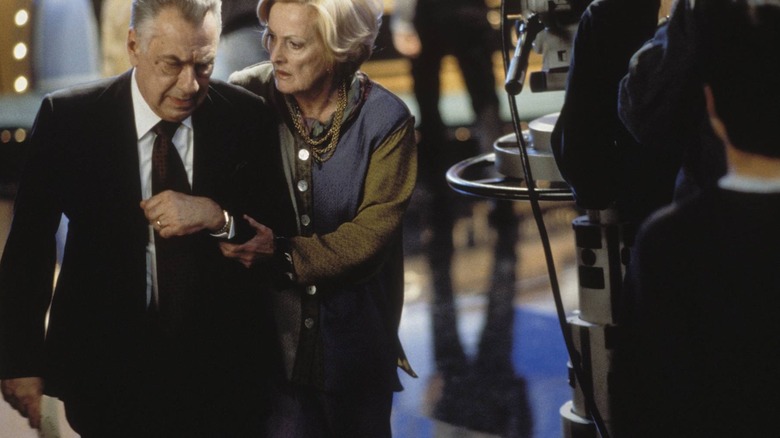
In Anderson's "Magnolia," Hall plays Jimmy Gator, the longtime host of "What Do Kids Know?," a fictional game show whereon child prodigies compete in a trivia competition. "Magnolia" takes place over the course of one day, and Jimmy's is going quite badly: He is dying of cancer, and drinks heavily to get through the day. On camera, Jimmy seems to be slowly coming undone. The audience later learns of another drama he is party to: He is attempting to reconcile with his estranged daughter (Melora Walters) who refuses to accept anything he has to say after the sexual abuse she suffered by his hand. Jimmy claims not to remember the abuse and is desperate to reconnect before he passes.
As the day continues, Jimmy deteriorates emotionally, admitting further wrongdoing to his wife Rose (Melinda Dillon). Jimmy is, he finally is able to openly admit to himself, not a great person. The climax of "Magnolia" is a shared event (no spoilers) that will give Jimmy and all the other characters a new perspective. Jimmy Gator is a rich, deep, exciting role for an actor, and Hall fills it with every iota of his talent, giving Jimmy a monstrous past and a human face.
"Magnolia" is available on Paramount+ and for free on Kanopy.
Cradle Will Rock

Tim Robbins' "Cradle Will Rock" takes place during the height of the government's Works Progress Administration, a widespread employment program enacted as part of the New Deal during the Great Depression. "Cradle" is specifically about the arts wing of the WPA called the Federal Theater Project, which guaranteed a level of government funding to the theatrical arts. However, because it was backed by the government, some uptight, racist congressmen (particularly one Martin Dies) accused the FTP of preaching Communist ideals in their plays and allowing too much racial integration. At the center of this fight was Marc Blitzstein's musical "The Cradle Will Rock," a social satire that confronted the government, the church, and the shallowness of pop entertainment.
"Cradle Will Rock" is, like "Magnolia," a giant ensemble piece that covers many angles of the Red Scare and how it related to the arts in the 1930s. Hall plays no one less than John D. Rockefeller, the famed philanthropist who buys art to support certain political candidates, but who has no personal passions for the arts whatsoever. Rockefeller is played as a grump with little patience for the artistic obsessions of his girlfriend, the Countess Constance LaGrange (Vanessa Redgrave). Robbins is careful to depict that art can be saved, although it's often for corrupt reasons. A Da Vinci will not be appreciated in the halls of rich people's houses.
"Cradle Will Rock" is streaming on Hoopla.
The Talented Mr. Ripley

In Anthony Minghella's dark thriller "The Talented Mr. Ripley," Hall only plays a minor role, but he provides a major plot twist that defined the conclusion of the movie. In "Mr. Ripley," Matt Damon stars as the title character, a wimpy, pale, bisexual dreamer with a compulsion toward deception. Tom Ripley is hired by the father of an old classmate named Dickie (Jude Law) to go to Italy and retrieve him before Dickie spends his entire family's fortune. Tom does so, but with a great deal of subterfuge. It won't take long before Tom will fall in love with Dickie and find himself in a twisted position to take his place. By the film's end, Tom has committed any number of sins to retain popularity, wealth, and the sexual partners he desires.
Hall plays a private investigator hired by Dickie's father to look into what's been happening. Without spoiling anything, Hall would appear to Tom Ripley, imply that he's under threat ... and then say the opposite of what is expected. Hall carries with him a natural threat and authority, so when he says what he says, it's a great sigh of relief for the audience ... or a sign that the world is corrupt and that bad people might be getting away with bad things.
"Mr. Ripley" is one of the best films of a year chock full of them. Just look up and down this list for more examples.
"The Talented Mr. Ripley" is on Peacock Premium.
The Insider
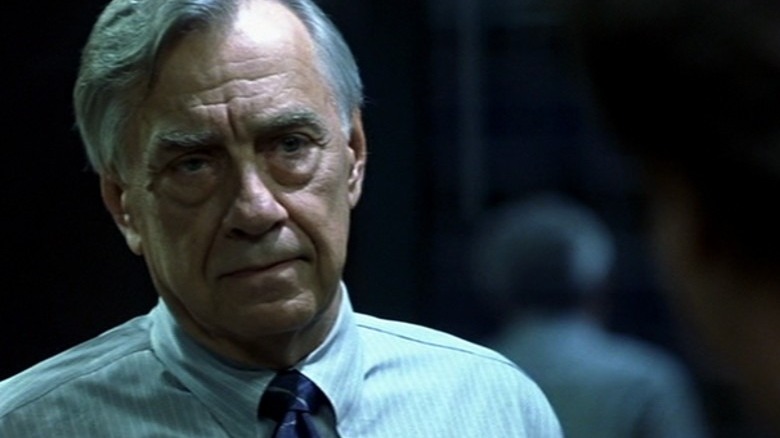
Nominated for the Academy Award for Best Picture in '99, Michael Mann's "The Insider" tells a fictionalized story of Jeffrey Wigand, a chemical engineer who works for the tobacco industry. In working on safer versions of cigarettes, Wigand discovers that many cigarette companies were intentionally including chemicals in their products to assure they were more addictive than they would be ordinarily. In Mann's film, Wigand is played by Russell Crowe, and his liaison to the media is journalist Lowell Bergman (Al Pacino). The film is an ice-veined delve into the complex politics of media reportage and how well whistleblowers are protected, if ever.
In "The Insider," Hall plays the real-life TV executive Don Hewitt, the creator of "60 Minutes." Because of Hall's natural authority, his words, however scant, have a deep and hard impact. "The Insider" is all about who and who does not have authority over information, and Hall plays a character who considers himself something of an information arbiter. He has to carefully weigh what is meant to be included and what is not on a show like "60 Minutes."
"The Insider" is not included on any streaming subscription services, but can be rented by various online outlets.
Let The Devil Wear Black

Few saw director Stacy Title's third feature "Let the Devil Wear Black" when it was released, and only Shakespeare nerds tend to know about its existence in 2022. "Black" was a hard-edged hipster version of "Hamlet" set in modern day L.A. with modern language, a lot more paranoia, and a good deal more sex. "Black" is a looser adaptation than most, although some critics declared it to be a far better effort than Michael Almareyda's "Hamlet" (the one with Ethan Hawke) a film that used Shakespeare's language, released the following year.
In "Black," Hall plays the Polonius character, the father of the Hamlet character's jilted girlfriend Ophelia (Mary Louise Parker). Polonius is traditionally depicted as a "wise fool," in that he says intelligent things, but kind of by accident. Polonius is a blowhard, and also a bit clueless and cruel when it comes to his children. In the original play, Polonius is killed by Hamlet long before the finale. If his fate matches in Title's film will have to be discovered by the curious. It's exhilarating to think that Philip Baker Hall had such an excellent year in 1999 that his Shakespearean performance is now seen as the least of what he did.
"Let the Devil Wear Black" is also not available on any streaming services, but it too can be rented and purchased online.
Read this next: Actors Who Died In 2021
The post 5 Brilliant Philip Baker Hall Movies and Where You Can Watch Them appeared first on /Film.
The Handmaid's Tale Season 5: Release Date, Cast, And More

(Welcome to ...And More, our no-frills, zero B.S. guide to when and where you can watch upcoming movies and shows, and everything else you could possibly stand to know.)
It's been nearly a year since the fourth season of "The Handmaid's Tale" ended on perhaps the biggest cliffhanger of the series yet, but there's a light at the end of Gilead as Hulu has finally announced the return for season 5. The popular series based on Margaret Atwood's dystopian novel of the same name became the first show produced by Hulu to win major awards, including the first series on a streaming service to win an Emmy for Outstanding Series. Since the show's debut in 2017, "The Handmaid's Tale" has become synonymous with the current political climate in America, with feminist protesters often donning the Handmaid's traditional clothing of the long red dress and oversized white coifs.
For the uninitiated, "The Handmaid's Tale" takes place following a second civil war, where a theonomic government has taken control and established a new totalitarian hierarchical regime based in religious fanaticism. After fertility rates collapsed as a result of sexually transmitted diseases and environmental pollution, women capable of birthing children considered to be "fallen women" (ie: they've had multiple marriages, are single or unmarried mothers, lesbians, non-Christians, adherents of Christian denominations other than the "Sons of Jacob", political dissidents, and academics) are treated as natal slaves, and forced to submit to ritualized rape by their male "masters" in the ruling elite to provide children for them. For someone like Elisabeth Moss' June Osborne (Offred/Ofjoseph), the only option is to fight back against this systemic injustice.
There are rumors that season 5 may be the series' last, so here's everything you need to know before it arrives.
The Handmaid's Tale Season 5 Release Date And Where You Can Watch It

The hit Hulu series will return on a Wednesday, September 14, 2022 with a two-episode premiere, with subsequent single episodes following weekly on Wednesdays. Unlike Netflix, which drops entire seasons at once, Hulu continues to follow a more traditional model with "The Handmaid's Tale," releasing weekly episodes to help build buzz and keep the conversation around their flagship show going for weeks and months at a time.
What The Handmaid's Tale Season 5 Is About
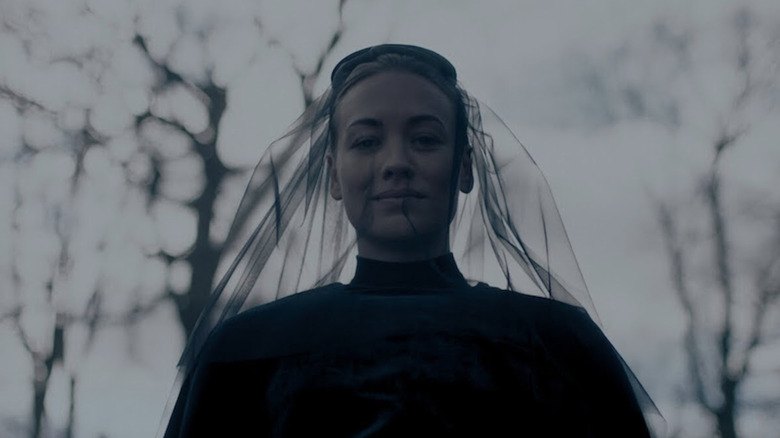
A lot has happened over the last four seasons of "The Handmaid's Tale" with the finale ending on a jaw-dropping cliffhanger. After recruiting the assistance of some fellow Handmaid refugees, June orchestrated the murder of her rapist Commander Fred Waterford (Joseph Fiennes). She returns home and holds her baby, with Waterford's decapitated body hanging above the phrase "Nolite te bastardes carburondorum," which translates to "Don't let the bastards grind you down." According to the official logline from Hulu:
"June faces consequences for killing Commander Waterford while struggling to redefine her identity and purpose. The widowed Serena attempts to raise her profile in Toronto as Gilead's influence creeps into Canada. Commander Lawrence works with Aunt Lydia as he tries to reform Gilead and rise in power. June, Luke, and Moira fight Gilead from a distance as they continue their mission to save and reunite with Hannah."
It's been implied that this season would be the conclusion of the story, as Hulu is also hard at work on another Margaret Atwood spin-off series, "The Testaments." It was made known that the series wouldn't arrive until the completion of "The Handmaid's Tale," leading many to believe that the show would end after this season to make way for the spin-off. It's important to note, however, that this has not yet been confirmed.
The Cast Of The Handmaid's Tale Season 5
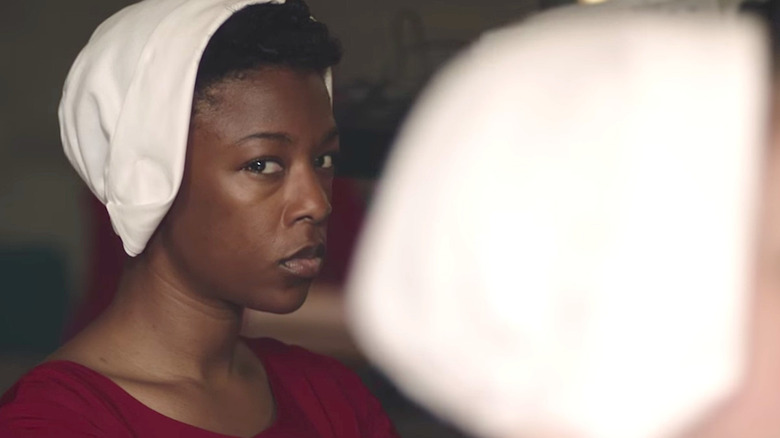
Most of the major (still alive) players of "The Handmaid's Tale" will return for season 5, including Elisabeth Moss as June Osbourne, Yvonne Strahovski as Serena Joy Waterford, Madeline Brewer as Janine Lindo, Ann Dowd as Aunt Lydia Clements, OT Fagbenle as Luke Bankole, Max Minghella as Commander Nick Blaine, Samira Wiley as Moira Strand, Amanda Brugel as Rita Blue, Bradley Whitford as Commander Joseph Lawrence, Sam Jaeger as Mark Tuello, McKenna Grace as Esther Keyes, Zawe Ashton as Moira's girlfriend Oona, Clea DuVall as Emily's wife, Sylvia, Charlie Zeltzer as Oliver, and Max Minghella as Commander Nick Blaine Sophie Giraud.
Christine Klo has been reportedly added to the cast as a new character named Lily, said to be a Gilead refugee who has become a leader in a Canadian based resistance movement. She's said to be a former "Martha," the social class ranked higher than Handmaids who are assigned to Commanders as household servants rather than sex slaves. Unfortunately, season 5 will not see the return of Alexis Bledel as Emily, who made the decision to leave the series following season 4. Bledel won an Emmy for her performance, but said, "After much thought, I felt I had to step away from 'The Handmaid's Tale' at this time."
The Handmaid's Tale Season 5 Writer, Director, And More

"The Handmaid's Tale" is produced by MGM Television and internationally distributed by MGM. Star Elisabeth Moss executive produces alongside showrunner Bruce Miller, Warren Littlefield, Daniel Wilson, Fran Sears, Eric Tuchman, Yahlin Chang, Rachel Shukert, Sheila Hockin, John Weber, Frank Siracusa, Steve Stark and Kim Todd. It's expected that as with previous seasons, a variety of writers and directors will contribute to the season, which means we'll hopefully see more episodes with Elisabeth Moss in the director's chair like we did last season.
Read this next: The 15 Best Anthology TV Series Ranked
The post The Handmaid's Tale Season 5: Release Date, Cast, and More appeared first on /Film.
[News] No One Can Be Trusted in GLASSHOUSE Trailer
![[News] No One Can Be Trusted in GLASSHOUSE Trailer](https://i0.wp.com/www.nightmarishconjurings.com/wp-content/uploads/2022/06/Glasshouse-vertical-1200x1600-1.jpg?resize=640%2C853&ssl=1)
Confined to their glasshouse, a family survives The Shred, a toxin that erases memory. Until the sisters are seduced by a Stranger who shatters their peace and stirs a past best left buried.
From director Kelsey Egan (Forever, Zulu), and starring Jessica Alexander (A Banquet, The Little Mermaid), Kitty Harris, Hilton Pelser (The Kissing Booth series, Moffie), Adrienne Pearce (The Red Sea Diving Resort, Tremors: A Cold Day in Hell), and Anja Taljaard (Redeeming Love, Double Echo), GLASSHOUSE premieres on digital platforms on July 12 in North America.
The post [News] No One Can Be Trusted in GLASSHOUSE Trailer appeared first on Nightmarish Conjurings.
System Shock - Official Trailer
Glass Onion: A Knives Out Mystery: Everything We Know So Far

Rian Johnson's "Knives Out" was everything box office hits weren't supposed to be when it came out in 2019. An original, mid-budget murder mystery, the film combines a top-notch cast of character actors with a script they could really sink their teeth into. The result is a thoroughly entertaining movie that delivers fun plot twists and turns aplenty, along with a timely-as-ever "Eat the Rich" message. In the end, Johnson wound up creating a better Agatha Christie-style whodunnit than the recent Kenneth Branagh films adapted from the author's work.
Johnson is now working on a pair of "Knives Out" sequels for Netflix, which shelled out almost half a billion dollars for the rights in March 2021 (snatching the franchise away from its original home at Lionsgate). The streamer has since confirmed that the first of those followups will thankfully have a more far interesting moniker than "Knives Out 2." It will instead go by the playful, if lengthy, title "Glass Onion: A Knives Out Mystery." (Gotta get that branding in there somehow, right?)
If you're ready to begin untangling this twisted web and uncover the smaller donut at the center of this donut, read on to find out everything we know about "Glass Onion" so far.
When And Where To Watch Glass Onion

Lionsgate announced its plans for a "Knives Out" sequel in February 2020, with CEO Jon Feltheimer stating, "a production start for a follow-up...is imminent." One pandemic and a massive Netflix buyout later, and the movie finally began shooting in Greece in June 2021. The streamer confirmed the film would release as part of its 2022 slate near the start of this year, simply listing it as "Knives Out 2" at the time. Thanks to the below video, however, the project is now going by its official name.
The video affirms that Daniel Craig's mystery-busting private detective Benoit Blanc will be back on the case "this holiday season," which aligns with previous reports that "Glass Onion" would arrive towards the end of the year (much like "Knives Out" debuted in late November in 2019). It's also been reported that Netflix wants the film to tour the festival circuit before it releases in, most likely, select theaters prior to streaming. So, if you were hoping to see Mr. Blanc back on the big screen, it seems you may have a shot at doing just that.
What We Think Glass Onion Will Be About

Along with the announcement video, Netflix revealed that "Glass Onion: A Knives Out Mystery" will follow Benoit Blanc as he "travels to Greece to peel back the layers of a mystery involving a new cast of suspects." (Because onions have layers, get it? Yeah, sorry, I know, I've seen "Shrek" too.) Lest we all get ahead of ourselves, though, it's probably best to not read too deeply into the movie's title and what it could portend for Mr. Blanc's next case.
You see, "Glass Onion" slyly takes its name from the 1968 Beatles song of the same name (which was itself released as part of the band's famous "White Album"). John Lennon wrote the tune with the intent of confusing The Beatles' fans, many of whom he felt were reading too much into the meaning of their often nonsensical lyrics. With that in mind, the story in "Knives Out" does, in fact, involve knives at one point, so who knows? Maybe Rian Johnson is out here playing four-dimensional chess, and onions will end up being a major plot point in the film.
What We Know About The Glass Onion Cast And Crew

"Glass Onion," like "Knives Out," is being produced and directed by Rian Johnson from his own script. The film once again reunites him with his trusty cinematographer Steve Yedlin, with "Knives Out" composer Nathan Johnson also back to provide the movie's score.
So far as we know (pending a surprise Ana de Armas cameo), Daniel Craig is the only "Knives Out" actor returning for "Glass Onion." Whether he will still have his 100 percent convincing Southern accent when he does is a mystery that only time can solve ... but most likely (although I'm still holding out hope Craig will don an entirely different accent for the sequel that no one ever comments on).
The rest of the "Glass Onion" cast is as star-studded as the supporting ensemble for "Knives Out." Indeed, its ranks include such famous faces as Dave Bautista ("Army of the Dead"), Janelle Monáe ("Hidden Figures"), Edward Norton ("Birdman"), Kathryn Hahn ("WandaVision"), and Leslie Odom Jr. ("One Night in Miami"), as well as Jessica Henwick ("The Matrix Resurrections"), Kate Hudson ("Marshall"), Ethan Hawke ("Moon Knight"), and Madelyn Cline ("Outer Banks"). But is there a killer among their ranks, that's the real question. I'm watching you closely, Mr. Hawke.
Read this next: The 14 Greatest War Movies Of The 21st Century
The post Glass Onion: A Knives Out Mystery: Everything We Know So Far appeared first on /Film.
The many lives of BlackCat ransomware
The BlackCat ransomware, also known as ALPHV, is a prevalent threat and a prime example of the growing ransomware-as-a-service (RaaS) gig economy. It’s noteworthy due to its unconventional programming language (Rust), multiple target devices and possible entry points, and affiliation with prolific threat activity groups. While BlackCat’s arrival and execution vary based on the actors deploying it, the outcome is the same—target data is encrypted, exfiltrated, and used for “double extortion,” where attackers threaten to release the stolen data to the public if the ransom isn’t paid.
First observed in November 2021, BlackCat initially made headlines because it was one of the first ransomware families written in the Rust programming language. By using a modern language for its payload, this ransomware attempts to evade detection, especially by conventional security solutions that might still be catching up in their ability to analyze and parse binaries written in such language. BlackCat can also target multiple devices and operating systems. Microsoft has observed successful attacks against Windows and Linux devices and VMWare instances.
As we previously explained, the RaaS affiliate model consists of multiple players: access brokers, who compromise networks and maintain persistence; RaaS operators, who develop tools; and RaaS affiliates, who perform other activities like moving laterally across the network and exfiltrating data before ultimately launching the ransomware payload. Thus, as a RaaS payload, how BlackCat enters a target organization’s network varies, depending on the RaaS affiliate that deploys it. For example, while the common entry vectors for these threat actors include remote desktop applications and compromised credentials, we also saw a threat actor leverage Exchange server vulnerabilities to gain target network access. In addition, at least two known affiliates are now adopting BlackCat: DEV-0237 (known for previously deploying Ryuk, Conti, and Hive) and DEV-0504 (previously deployed Ryuk, REvil, BlackMatter, and Conti).
Such variations and adoptions markedly increase an organization’s risk of encountering BlackCat and pose challenges in detecting and defending against it because these actors and groups have different tactics, techniques, and procedures (TTPs). Thus, no two BlackCat “lives” or deployments might look the same. Indeed, based on Microsoft threat data, the impact of this ransomware has been noted in various countries and regions in Africa, the Americas, Asia, and Europe.
Human-operated ransomware attacks like those that deploy BlackCat continue to evolve and remain one of the attackers’ preferred methods to monetize their attacks. Organizations should consider complementing their security best practices and policies with a comprehensive solution like Microsoft 365 Defender, which offers protection capabilities that correlate various threat signals to detect and block such attacks and their follow-on activities.
In this blog, we provide details about the ransomware’s techniques and capabilities. We also take a deep dive into two incidents we’ve observed where BlackCat was deployed, as well as additional information about the threat activity groups that now deliver it. Finally, we offer best practices and recommendations to help defenders protect their organizations against this threat, including hunting queries and product-specific mitigations.
BlackCat’s anatomy: Payload capabilities
As mentioned earlier, BlackCat is one of the first ransomware written in the Rust programming language. Its use of a modern language exemplifies a recent trend where threat actors switch to languages like Rust or Go for their payloads in their attempt to not only avoid detection by conventional security solutions but also to challenge defenders who may be trying to reverse engineer the said payloads or compare them to similar threats.
BlackCat can target and encrypt Windows and Linux devices and VMWare instances. It has extensive capabilities, including self-propagation configurable by an affiliate for their usage and to environment encountered.
In the instances we’ve observed where the BlackCat payload did not have administrator privileges, the payload was launched via dllhost.exe, which then launched the following commands below (Table 1) via cmd.exe. These commands could vary, as the BlackCat payload allows affiliates to customize execution to the environment.
The flags used by the attackers and the options available were the following: -s -d -f -c; –access-token; –propagated; -no-prop-servers

| Command | Description |
| [service name] /stop | Stops running services to allow encryption of data |
| vssadmin.exe Delete Shadows /all /quiet | Deletes backups to prevent recovery |
| wmic.exe Shadowcopy Delete | Deletes shadow copies |
| wmic csproduct get UUID | Gets the Universally Unique Identifier (UUID) of the target device |
| reg add HKEY_LOCAL_MACHINE\SYSTEM\CurrentControlSet\Services \LanmanServer\Parameters /v MaxMpxCt /d 65535 /t REG_DWORD /f | Modifies the registry to change MaxMpxCt settings; BlackCat does this to increase the number of outstanding requests allowed (for example, SMB requests when distributing ransomware via its PsExec methodology) |
| for /F \”tokens=*\” %1 in (‘wevtutil.exe el’) DO wevtutil.exe cl \”%1\” | Clears event logs |
| fsutil behavior set SymlinkEvaluation R2L:1 | Allows remote-to-local symbolic links; a symbolic link is a file-system object (for example, a file or folder) that points to another file system object, like a shortcut in many ways but more powerful |
| fsutil behavior set SymlinkEvaluation R2R:1 | Allows remote-to-remote symbolic links |
| net use \\[computer name] /user:[domain]\[user] [password] /persistent:no | Mounts network share |
User account control (UAC) bypass
BlackCat can bypass UAC, which means the payload will successfully run even if it runs from a non-administrator context. If the ransomware isn’t run with administrative privileges, it runs a secondary process under dllhost.exe with sufficient permissions needed to encrypt the maximum number of files on the system.
Domain and device enumeration
The ransomware can determine the computer name of the given system, local drives on a device, and the AD domain name and username on a device. The malware can also identify whether a user has domain admin privileges, thus increasing its capability of ransoming more devices.
Self-propagation
BlackCat discovers all servers that are connected to a network. The process first broadcasts NetBIOS Name Service (NBNC) messages to check for these additional devices. The ransomware then attempts to replicate itself on the answering servers using the credentials specified within the config via PsExec.
Hampering recovery efforts
BlackCat has numerous methods to make recovery efforts more difficult. The following are commands that might be launched by the payload, as well as their purposes:
- Modify boot loader
- “C:\Windows\system32\cmd.exe” /c “bcdedit /set {default}”
- “C:\Windows\system32\cmd.exe” /c “bcdedit /set {default} recoveryenabled No”
- Delete volume shadow copies
- “C:\Windows\system32\cmd.exe” /c “vssadmin.exe Delete Shadows /all /quiet”
- “C:\Windows\system32\cmd.exe” /c “wmic.exe Shadowcopy Delete”
- Clear Windows event logs
- “C:\Windows\system32\cmd.exe” /c “cmd.exe /c for /F \”tokens=*\” Incorrect function. in (‘ wevtutil.exe el ‘) DO wevtutil.exe cl \”Incorrect function. \””
Slinking its way in: Identifying attacks that can lead to BlackCat ransomware
Consistent with the RaaS model, threat actors utilize BlackCat as an additional payload to their ongoing campaigns. While their TTPs remain largely the same (for example, using tools like Mimikatz and PsExec to deploy the ransomware payload), BlackCat-related compromises have varying entry vectors, depending on the ransomware affiliate conducting the attack. Therefore, the pre-ransom steps of these attacks can also be markedly different.
For example, our research noted that one affiliate that deployed BlackCat leveraged unpatched Exchange servers or used stolen credentials to access target networks. The following sections detail the end-to-end attack chains of these two incidents we’ve observed.
Case study 1: Entry via unpatched Exchange
In one incident we’ve observed, attackers took advantage of an unpatched Exchange server to enter the target organization.

Discovery
Upon exploiting the Exchange vulnerability, the attackers launched the following discovery commands to gather information about the device they had compromised:
- cmd.exe and the commands ver and systeminfo – to collect operating system information
- net.exe – to determine domain computers, domain controllers, and domain admins in the environment
After executing these commands, the attackers navigated through directories and discovered a passwords folder that granted them access to account credentials they could use in the subsequent stages of the attack. They also used the del command to delete files related to their initial compromise activity.
The attackers then mounted a network share using net use and the stolen credentials and began looking for potential lateral movement targets using a combination of methods. First, they used WMIC.exe using the previously gathered device name as the node, launched the command whoami /all, and pinged google.com to check network connectivity. The output of the results were then written to a .log file on the mounted share. Second, the attackers used PowerShell.exe with the cmdlet Get-ADComputer and a filter to gather the last sign-in event.
Lateral movement
Two and a half days later, the attackers signed into one of the target devices they found during their initial discovery efforts using compromised credentials via interactive sign-in. They opted for a credential theft technique that didn’t require dropping a file like Mimikatz that antivirus products might detect. Instead, they opened Taskmgr.exe, created a dump file of the LSASS.exe process, and saved the file to a ZIP archive.
The attackers continued their previous discovery efforts using a PowerShell script version of ADRecon (ADRecon.ps1), which is a tool designed to gather extensive information about an Active Directory (AD) environment. The attacker followed up this action with a net scanning tool that opened connections to devices in the organization on server message block (SMB) and remote desktop protocol (RDP). For discovered devices, the attackers attempted to navigate to various network shares and used the Remote Desktop client (mstsc.exe) to sign into these devices, once again using the compromised account credentials.
These behaviors continued for days, with the attackers signing into numerous devices throughout the organization, dumping credentials, and determining what devices they could access.
Collection and exfiltration
On many of the devices the attackers signed into, efforts were made to collect and exfiltrate extensive amounts of data from the organization, including domain settings and information and intellectual property. To do this, the attackers used both MEGAsync and Rclone, which were renamed as legitimate Windows process names (for example, winlogon.exe, mstsc.exe).
Exfiltration of domain information to identify targets for lateral movement
Collecting domain information allowed the attackers to progress further in their attack because the said information could identify potential targets for lateral movement or those that would help the attackers distribute their ransomware payload. To do this, the attackers once again used ADRecon.ps1with numerous PowerShell cmdlets such as the following:
- Get-ADRGPO – gets group policy objects (GPO) in a domain
- Get-ADRDNSZone – gets all DNS zones and records in a domain
- Get-ADRGPLink – gets all group policy links applied to a scope of management in a domain
Additionally, the attackers dropped and used ADFind.exe commands to gather information on persons, computers, organizational units, and trust information, as well as pinged dozens of devices to check connectivity.
Exfiltration for double extortion
Intellectual property theft likely allowed the attackers to threaten the release of information if the subsequent ransom wasn’t paid—a practice known as “double extortion.” To steal intellectual property, the attackers targeted and collected data from SQL databases. They also navigated through directories and project folders, among others, of each device they could access, then exfiltrated the data they found in those.
The exfiltration occurred for multiple days on multiple devices, which allowed the attackers to gather large volumes of information that they could then use for double extortion.
Encryption and ransom
It was a full two weeks from the initial compromise before the attackers progressed to ransomware deployment, thus highlighting the need for triaging and scoping out alert activity to understand accounts and the scope of access an attacker gained from their activity. Distribution of the ransomware payload using PsExec.exe proved to be the most common attack method.

Case study 2: Entry via compromised credentials
In another incident we observed, we found that a ransomware affiliate gained initial access to the environment via an internet-facing Remote Desktop server using compromised credentials to sign in.

Lateral movement
Once the attackers gained access to the target environment, they then used SMB to copy over and launch the Total Deployment Software administrative tool, allowing remote automated software deployment. Once this tool was installed, the attackers used it to install ScreenConnect (now known as ConnectWise), a remote desktop software application.
Credential theft
ScreenConnect was used to establish a remote session on the device, allowing attackers interactive control. With the device in their control, the attackers used cmd.exe to update the Registry to allow cleartext authentication via WDigest, and thus saved the attackers time by not having to crack password hashes. Shortly later, they used the Task Manager to dump the LSASS.exe process to steal the password, now in cleartext.
Eight hours later, the attackers reconnected to the device and stole credentials again. This time, however, they dropped and launched Mimikatz for the credential theft routine, likely because it can grab credentials beyond those stored in LSASS.exe. The attackers then signed out.
Persistence and encryption
A day later, the attackers returned to the environment using ScreenConnect. They used PowerShell to launch a command prompt process and then added a user account to the device using net.exe. The new user was then added to the local administrator group via net.exe.
Afterward, the attackers signed in using their newly created user account and began dropping and launching the ransomware payload. This account would also serve as a means of additional persistence beyond ScreenConnect and their other footholds in the environment to allow them to re-establish their presence, if needed. Ransomware adversaries are not above ransoming the same organization twice if access is not fully remediated.
Chrome.exe was used to navigate to a domain hosting the BlackCat payload. Notably, the folder structure included the organization name, indicating that this was a pre-staged payload specifically for the organization. Finally, the attackers launched the BlackCat payload on the device to encrypt its data.
Ransomware affiliates deploying BlackCat
Apart from the incidents discussed earlier, we’ve also observed two of the most prolific affiliate groups associated with ransomware deployments have switched to deploying BlackCat. Payload switching is typical for some RaaS affiliates to ensure business continuity or if there’s a possibility of better profit. Unfortunately for organizations, such adoption further adds to the challenge of detecting related threats.
Microsoft tracks one of these affiliate groups as DEV-0237. Also known as FIN12, DEV-0237 is notable for its distribution of Hive, Conti, and Ryuk ransomware. We’ve observed that this group added BlackCat to their list of distributed payloads beginning March 2022. Their switch to BlackCat from their last used payload (Hive) is suspected to be due to the public discourse around the latter’s decryption methodologies.
DEV-0504 is another active affiliate group that we’ve seen switching to BlackCat for their ransomware attacks. Like many RaaS affiliate groups, the following TTPs might be observed in a DEV-0504 attack:
- Entry vector that can involve the affiliate remotely signing into devices with compromised credentials, such as into devices running software solutions that allow for remote work
- The attackers’ use of their access to conduct discovery on the domain
- Lateral movement that potentially uses the initial compromised account
- Credential theft with tools like Mimikatz and Rubeus
DEV-0504 typically exfiltrates data on devices they compromise from the organization using a malicious tool such as StealBit—often named “send.exe” or “sender.exe”. PsExec is then used to distribute the ransomware payload. The group has been observed delivering the following ransom families before their adoption of BlackCat beginning December 2021:
- BlackMatter
- Conti
- LockBit 2.0
- Revil
- Ryuk
Defending against BlackCat ransomware
Today’s ransomware attacks have become more impactful because of their growing industrialization through the RaaS affiliate model and the increasing trend of double extortion. The incidents we’ve observed related to the BlackCat ransomware leverage these two factors, making this threat durable against conventional security and defense approaches that only focus on detecting the ransomware payloads. Detecting threats like BlackCat, while good, is no longer enough as human-operated ransomware continues to grow, evolve, and adapt to the networks they’re deployed or the attackers they work for.
Instead, organizations must shift their defensive strategies to prevent the end-to-end attack chain. As noted above, while attackers’ entry points may vary, their TTPs remain largely the same. In addition, these types of attacks continue to take advantage of an organization’s poor credential hygiene and legacy configurations or misconfigurations to succeed. Therefore, defenders should address these common paths and weaknesses by hardening their networks through various best practices such as access monitoring and proper patch management. We provide detailed steps on building these defensive strategies against ransomware in this blog.
In the BlackCat-related incidents we’ve observed, the common entry points for ransomware affiliates were via compromised credentials to access internet-facing remote access software and unpatched Exchange servers. Therefore, defenders should review their organization’s identity posture, carefully monitor external access, and locate vulnerable Exchange servers in their environment to update as soon as possible. The financial impact, reputation damage, and other repercussions that stem from attacks involving ransomware like BlackCat are not worth forgoing downtime, service interruption, and other pain points related to applying security updates and implementing best practices.
Leveraging Microsoft 365 Defender’s comprehensive threat defense capabilities
Microsoft 365 Defender helps protect organizations from attacks that deliver the BlackCat ransomware and other similar threats by providing cross-domain visibility and coordinated threat defense. It uses multiple layers of dynamic protection technologies and correlates threat data from email, endpoints, identities, and cloud apps. Microsoft Defender for Endpoint detects tools like Mimikatz, the actual BlackCat payload, and subsequent attacker behavior. Threat and vulnerability management capabilities also help discover vulnerable or misconfigured devices across different platforms; such capabilities could help detect and block possible exploitation attempts on vulnerable devices, such as those running Exchange. Finally, advanced hunting lets defenders create custom detections to proactively surface this ransomware and other related threats.
Additional mitigations and recommendations
Defenders can also follow the following steps to reduce the impact of this ransomware:
- Turn on Microsoft Defender Antivirus. Turn on cloud-delivered protection in Microsoft Defender Antivirus or the equivalent for your antivirus product to cover rapidly evolving attacker tools and techniques. Cloud-based machine learning protections block a large amount of new and unknown variants.
- Enforce strong, randomized local administrator passwords. Use tools like Local Administrator Password Solution (LAPS).
- Require multifactor authentication (MFA) for local device access, RDP access, and remote connections through virtual private networks (VPNs) and Outlook Web Access. Solutions like Windows Hello or Fast ID Online (FIDO) v2.0 security keys let users sign in using biometrics and/or a physical key or device.
- Turn on Microsoft Defender Firewall.
- Implement controlled folder access to help prevent files from being altered or encrypted by ransomware. Set controlled folder access to Enabled or Audit mode.
- Investigate and remediate vulnerabilities in Exchange servers. Also, determine if implementing the Exchange Emergency Mitigation service is feasible for your environment. This service helps keep your Exchange servers secure by applying mitigations to address potential threats against your servers.
Microsoft 365 Defender customers can also apply the additional mitigations below:
- Use advanced protection against ransomware.
- Turn on tamper protection in Microsoft Defender for Endpoint to prevent malicious changes to security settings. Enable network protection in Microsoft Defender for Endpoint and Microsoft 365 Defender to prevent applications or users from accessing malicious domains and other malicious content on the internet.
- Ensure Exchange servers have applied the mitigations referenced in the related Threat Analytics report.
- Turn on the following attack surface reduction rules to block or audit activity associated with this threat:
- Block credential stealing from the Windows local security authority subsystem (lsass.exe)
- Block process creations originating from PSExec and WMI commands
- Block executable files from running unless they meet a prevalence, age, or trusted list criterion
For a full list of ransomware mitigations regardless of threat, refer to this article: Rapidly protect against ransomware and extortion.
Microsoft 365 Defender Threat Intelligence Team
Appendix
Microsoft 365 Defender detections
Microsoft Defender Antivirus
Microsoft Defender for Endpoint EDR
Alerts with the following titles in the security center can indicate threat activity on your network:
- An active ‘BlackCat’ ransomware was detected
- ‘BlackCat’ ransomware was detected
- BlackCat ransomware
Hunting queries
Microsoft 365 Defender
To locate possible ransomware activity, run the following queries.
Suspicious process execution in PerfLogs path
Use this query to look for processes executing in PerfLogs—a common path used to place the ransomware payloads.
DeviceProcessEvents
| where InitiatingProcessFolderPath has "PerfLogs"
| where InitiatingProcessFileName matches regex "[a-z]{3}.exe"
| extend Length = strlen(InitiatingProcessFileName)
| where Length == 7
Suspicious registry modification of MaxMpxCt parameters
Use this query to look for suspicious running processes that modify registry settings to increase the number of outstanding requests allowed (for example, SMB requests when distributing ransomware via its PsExec methodology).
DeviceProcessEvents
| where ProcessCommandLine has_all("LanmanServer", "parameters", "MaxMpxCt", "65535")
Suspicious command line indicative of BlackCat ransom payload execution
Use these queries to look for instances of the BlackCat payload executing based on a required command argument for it to successfully encrypt ‘–access-token’.
DeviceProcessEvents
| where ProcessCommandLine has_all("--access-token", "-v")
| extend CommandArguments = split(ProcessCommandLine, " ")
| mv-expand CommandArguments
| where CommandArguments matches regex "^[A-Fa-f0-9]{64}$"
DeviceProcessEvents | where InitiatingProcessCommandLine has "--access-token" | where ProcessCommandLine has "get uuid"
Suspected data exfiltration
Use this query to look for command lines that indicate data exfiltration and the indication that an attacker may attempt double extortion.
DeviceNetworkEvents
| where InitiatingProcessCommandLine has_all("copy", "--max-age", "--ignore-existing", "--multi-thread-streams", "--transfers") and InitiatingProcessCommandLine has_any("ftp", "ssh", "-q")
The post The many lives of BlackCat ransomware appeared first on Microsoft Security Blog.
Quick and Simple: BPFDoor Explained
Researchers Disclose Rooting Backdoor in Mitel IP Phones for Businesses
Cramer Curse Strike Again: Crypto Carnage Deepens as Ethereum Investors Run for Cover Amid stETH De-pegging and the Resulting DeFi Space Turmoil

Jim Cramer, the CNBC anchor whose recommendations have become famous recently for consistently generating alpha provided that investors take a diametrically opposite trade to the one recommended by Cramer himself, had heralded red days ahead for the broader crypto sphere by issuing a “buy” recommendation for Ethereum and Bitcoin on the 08th of June. Well, just five days later, the crypto world has been engulfed in the proverbial fire and brimstone.
Jim Cramer recommends buying #Bitcoin and #Ethereum, Oh No pic.twitter.com/O3JZr4CPp7
— Defi Butt ⟠ (@defi_butt) June 8, 2022
The ongoing carnage in Ethereum and the rest of the crypto sphere has two main stimulants behind it: the macroeconomic headwinds and the DeFi space turmoil spurred by stETH’s de-pegging. Let’s go over these factors in detail.
The Federal Reserve’s Firming Hawkish Stance Spells Further Weakness for the Crypto Sphere
ICYMI:
U.S. May Headline Inflation Rises 8.6% Y/Y; Est. 8.3%
Airfares expanded at the highest pace since 1980. Food at home recorded the largest increase since 1979. https://t.co/nPvjOevQZU pic.twitter.com/ddO5Csknw5
— Cable FX Macro (@cablefxmacro) June 10, 2022
On the 10th of June, the much-anticipated US CPI report for the month of May was published, ushering in turmoil in the risk asset universe. To wit, the headline inflation for May rose 8.6 percent on a year-on-year basis to the highest level since 1980. Core inflation – a metric that excludes the more volatile food and energy items – also came in hotter than anticipated. This development firmed up the Federal Reserve’s interest rate increase trajectory by removing the so-called interest rate hike pause that the market had started to price in for the month of September. As we’ve previously explained, rising interest rates spell trouble for growth-heavy, high beta stocks as they reduce the present value of future cash flows (by increasing the discount rate for such cash flows), thereby reducing the appeal for holding such equities.
US Treasury curve is now pricing in ten Fed rate hikes of 25 bp by year end. There are five Fed meetings before year end (starting with this week). The bloodless verdict of the market is a 50 bp hike every meeting unless JP puts bigger individual hikes “on the table” before that.
— Jeffrey Gundlach (@TruthGundlach) June 13, 2022
We’ve also repeatedly highlighted the ongoing strong correlation regime between growth-heavy US equities and the broader crypto sphere, including Bitcoin and Ethereum, in general. This correlation regime has been bolstered by synchronous liquidation waves that seemingly strike US equities and the crypto sphere in tandem. We’ve previously noted that as long as the current correlation regime holds strong, investors should not expect Ethereum, Bitcoin, and other major cryptocurrencies to bottom out, at least not until US equities also do so. For an inkling as to when this can occur, readers should note that Morgan Stanley’s Michael Wilson now sees the S&P 500 index bottoming out at around the $3,400 price level. With the benchmark index currently trading at the $3,900 handle, sizable downside potential still remains for US equities and the wider crypto sphere.
DeFi Space Turmoil Spurred by stETH Is Now Spilling Over to Ethereum and the Wider Crypto Arena
Regardless of Cramer’s so-called crypto death knell and the Federal Reserve’s relentless efforts to hammer risk assets in order to subdue the wealth effect pervading the US economy, Ethereum’s latest bout of weakness is at least partially a result of the crypto sector’s endogenous factors.
As a refresher, Lido-staked Ethereum (stETH) is a Decentralized Finance (DeFi) variant of Ethereum that is issued against staked Ethereum coins. stETH can be redeemed for Ethereum on a 1:1 basis but only after the Ethereum 2 transition takes place following the merge event. Therefore, stETH behaves like a stablecoin that is fully backed by Ethereum but without any direct price stabilization mechanism between the two coins. Still, stETH is widely used as collateral in the DeFi space to borrow Ethereum.
This brings us to the crux of the matter. stETH started de-pegging from its theoretical 1:1 ratio with Ethereum on Thursday when Alameda Capital dumped stETH worth around $1.5 billion, reducing its stETH holdings to zero in the process.
Since then, the theoretical peg between stETH and Ethereum could not be restored, with ETH currently trading at $1,228 while stETH is trading at 1,161 right now.
stETH
Pool imbalance worsening. Liquidity being withdrawn.
Only one thing happens next. pic.twitter.com/KO3aG14AS1
— CryptoJoe (@Crypto_Joe10) June 13, 2022
Of course, as stETH’s de-pegging deepens, it can lead to a liquidation of positions that have used stETH as collateral on various DeFi platforms, causing an even more painful de-pegging. While this liquidation has no direct impact on Ethereum, it is severely impacting the sentiment around the world’s second-largest cryptocurrency, resulting in synchronous losses with stETH. In fact, Ethereum has now tumbled to its 2018 highs.
The following Thread explains these dynamics in detail.
stETH is depegged, trading at .95
Liq is drying up & smart money is pulling capital. Coupled w/ the rumoured risk of Celsius' functional insolvency, there could be significant selling
Me & @Riley_gmi & have been researching this for the past week
Here is what we found pic.twitter.com/wtgFA779Np
— CryptoJoe (@Crypto_Joe10) June 10, 2022
Compounding the situation, the crypto lending and staking platform, Celsius, has now halted all user withdrawals, citing “extreme market conditions”. Nonetheless, there are reports that Nexo might purchase some of Celsius’ distressed assets.
JUST IN: Nexo is planning to offer Celsius a buyout on certain assets.
— Watcher.Guru (@WatcherGuru) June 13, 2022
Amid this turmoil, the global market capitalization of the crypto sphere has tumbled to below $1 trillion.

Based on Ethereum’s current price, around 47 percent of its total addresses are still in profit. However, with over 44 percent of the total addresses now sitting on losses, the chances of a disorderly liquidation are ramping up significantly.
The post Cramer Curse Strike Again: Crypto Carnage Deepens as Ethereum Investors Run for Cover Amid stETH De-pegging and the Resulting DeFi Space Turmoil by Rohail Saleem appeared first on Wccftech.
Apple Pay Later Will Be Limited to up to $1,000, Preventing Customers From Ordering Top-End Hardware

The Apple Pay Later announcement was a sigh of relief for customers that wanted to purchase top-tier hardware but were unable to because of their ludicrous pricing levels. Unfortunately, there are some caveats that Apple has put in place for consumers, irrespective if you have a history of purchasing products belonging to the company’s lineup. Apparently, the service will only allow you to borrow a maximum of $1,000, and that too with some conditions.
The $1,000 Limit Will Also Depend on Your Credit Rating, With Apple Expected to Run Thorough Background Checks
Even if a customer has a terrific credit rating, a report from The Wall Street Journal claims that Apple still intends to limit the borrowed amount to $1,000. The Apple Pay Later feature is expected to arrive when iOS 16 is officially available for compatible devices this fall, and Apple will reportedly run background checks on people through their Apple ID and other sources to see if they are eligible for a specific borrowed amount.
Assuming those customers have a history of payment problems, the Apple Pay Later feature may outright refuse to lend those individuals any sum. Even if you qualify for Apple’s rumored financial limit, it will hardly bring any benefit to the table, seeing as how expensive the majority of products are. For instance, the $1,000 limit will only allow you to purchase the base version of the iPhone 13 Pro or the M1 MacBook Air with an impressive level of internal storage.
As you move to the pricier members of the product family, it will become difficult for customers to acquire those devices and machines without a higher sum being allocated. Then again, it should be noted that Apple will finance its service through its own funds, and even if it has billions in cash reserves, it is not prudent to put money at risk just to facilitate customers.
Apple can increase the $1,000 limit in the future, allowing customers to obtain access to more powerful and pricier goods.
The post Apple Pay Later Will Be Limited to up to $1,000, Preventing Customers From Ordering Top-End Hardware by Omar Sohail appeared first on Wccftech.
Facilitating Convergence of Physical Security and Cyber Security With Open Source Intelligence
The desire to merge aspects of physical and cyber security is nothing new, especially in maturing enterprises that are proactively extending their security capabilities. Since many aspects of physical security are connected to the internet, enterprises have started to build fusion centers that combine disciplines. By doing so, they are able to converge cyber and physical security, close gaps in coverage, and scale security to protect facilities and hundreds of thousands of employees.
Anne Frank was born 93 years ago, but her diary still offers many powerful yet inspirational lessons about the dangers -- and rewards -- of flying an airplane while blind [Interesting]
Get Shantae and the Pirate's Curse for Free
Resident Evil 7 system requirements

With the introduction of ray tracing via a recent upgrade patch, the Resident Evil 7 system requirements now require higher specs from your gaming PC. Support for DirectX 12 is now a must, which may lead to some older systems needing an upgrade or two.
You'll now need to install Windows 11 or 10 in order to meet the updated Resident Evil 7 system requirements, in addition to making sure your rig has a compatible GPU. Thankfully, the barrier to entry isn't too high, with the Nvidia GeForce GTX 960 and AMD Radeon RX 460 make up the new minimum specs for the horror game
Those with the best graphics cards have nothing to fear from the new Resident Evil 7 system requirements, and will be able to enjoy all the scares the game has to offer with a new coat of ray tracing paint. Resident Evil 2 and Resident Evil 3 have also received the same upgrade treatment, and so you’ll need the same specs listed here to run those games too.
No Man’s Sky Leviathan 3.92 Update detailed and here are its full patch notes
Hello Games has detailed a new patch that will be coming out soon for No Man’s Sky. According to the release notes, the Leviathan 3.92 Update fixes a number of bugs that plagued the game. Going into more details, the Leviathan 3.92 Patch fixes an issue which incorrectly caused players to take damage while on … Continue reading No Man’s Sky Leviathan 3.92 Update detailed and here are its full patch notes →
The post No Man’s Sky Leviathan 3.92 Update detailed and here are its full patch notes appeared first on DSOGaming.
Spiderhead Review: An Odd Blend Of Philosophical Sci-Fi, Psychological Thriller, And Dystopian Satire

Netflix has been reserved in promoting their sci-fi thriller "Spiderhead," and after watching the movie, I understand why. Starring Chris Hemsworth in a decidedly not heroic role, the movie is an odd blend of philosophical science-fiction, psychological thriller, and dystopian satire. This is a heady mix that feels designed by director Joseph Kosinski to pursue cult classic status, but whether or not the film will actually succeed in this aim remains to be seen.
"Spiderhead" is the story of an experimental facility (deemed Spiderhead) where incarcerated felons are used to test experimental pharmaceuticals. The drug trials are run by warden Steve Abnesti (Chris Hemsworth), a scientist as brilliant as he is charismatic. Those at the facility enjoy the freedom to roam the halls of Spiderhead freely; however, this "freedom" is limited. The building is extremely isolated, and prisoners have very little — if any — contact with the outside world. Inmate Jeff (Miles Teller) finds himself at the center of an increasingly disturbing progression of experiments that eventually (and predictable) leads to tragedy.
Kosinski — who also directed the recent hit "Top Gun: Maverick" — designs a captivating world for "Spiderhead." Limiting the action to almost exclusively the facility itself, care went into making the space feel lived-in and realistic while also being claustrophobic and oppressive. There are glimpses of Abnesti's influence everywhere: his '80s playlist echoing through the halls, and splashes of bright yellow and orange on the walls, furniture, and decor; rather than add a friendly note to the surroundings, these serve as chilling reminders to those living in Spiderhead that they are in Abnesti's domain. Sure, these people enjoy privileges not afforded to those in the traditional prison system, but the cost is being completely vulnerable to the whims of a single, egomaniacal man.
Hemsworth Plays An American Psycho

In 2000, Mary Harron — a Canadian critic-turned-filmmaker — confused many people with her satirical thriller "American Psycho." Harron co-wrote the movie with Guinevere Turner, based on the 1991 novel "American Psycho" by Bret Easton Ellis. The story is set in the '80s, using yuppie culture as a lens through which to condemn consumerism. The two women infused the story with a dry, darkly comedic edge that not only honors the novel's anti-capitalist themes and transgressive plot, but also offers a poignant message at the end: as a handsome, affluent, white, cis male, serial killer Patrick Bateman (Christian Bale) will never get the punishment he deserves.
"Spiderhead" feels like a spiritual successor to "American Psycho," for better or worse. Steve Abnesti is clearly modeled after Patrick Bateman: his hair, glasses, and classic good looks are reminiscent of Christian Bale's interpretation of the character; his preference for decidedly '80 hits is almost certainly a nod to "American Pyscho's" setting; and, there are hints throughout that — like Patrick Bateman — Abnesti is a sociopath, driven by greed and incapable of empathy.
Rather than criticize consumerism though, "Spiderhead" is more generally an allegory for abusive relationships, with Abnesti taking the role of abuser and his test subjects, victims. Abnesti presents himself as an affable, kind man, but he expertly manipulates and lies to those around him (including assistant Verlaine, played by Mark Paguio); he knows how to feign sympathy and concern while leveraging the situation for personal benefit. Jeff and Lizzy (Jurnee Smollett) feel powerless in the situation, admitting at one point that more than anything, Abnesti's treatment leaves them feeling ashamed. It's an interesting thesis for a film, but the nature of this topic isn't exactly ripe for satire.
An Enjoyable Mixed Bag

The performances in "Spiderhead" propel the story forward. Chris Hemsworth — my favorite of the "Hollywood Chrises" — is in top form. Hemsworth steals every scene he's in, allowing Abnesti's dark impulses to simmer under his sexy surface. Smollett and Teller have excellent chemistry onscreen, giving the audience something to root for. Paguio's another standout: his looks of consternation and dismay set up Abnesti's dark turns. Even the most shocking twists are still organic to the story. Having said that, the tone and pacing are uneven; the story is smartly written, and it challenges audiences without being confusing, but the way events are presented and the approach to the content is inconsistent.
Unfortunately, "Spiderhead" lacks some of the bite of its inspiration "American Psycho." The target of satire here is less sharp, with Hemsworth's Steve Abnesti being the clear villain working against Jeff, the film's hero. Often, the film drifts into being a straightforward sci-fi thriller with Jeff and Abnesti working against each other's interests, and Kosinski struggles to balance the humor with earnest pathos. At first watch, it's not really clear what the movie is trying to do: Is it a comedy? A thriller? A message-driven sci-fi with satirical moments? Ultimately, I think the answer is all three.
"Spiderhead" is a movie that defies conventional genre labels, and while Kosinski isn't always successful in balancing the various elements, I have to admit: this is one hell of a ride. The '80s pop soundtrack is super fun, and the production design consistently interesting. There are plenty of frills, chills and thrills in this tight 106-minute story. By no means a flawless execution, 'Spiderhead" is a compelling story that had me hooked from the opening shot to the closing credits. Fans of sci-fi, satire, and all things weird — this one is for you.
/Film Rating: 7.5 out of 10
Read this next: 13 Box Office Bombs That Are Truly Worth A Watch
The post Spiderhead Review: An Odd Blend of Philosophical Sci-Fi, Psychological Thriller, and Dystopian Satire appeared first on /Film.
Folk Horror World Tour: 10 International Titles From The Last 100 Years

Folk horror is more than just pagan cults in the British Isles immolating Christians, or Christian cults in the American Midwest crucifying people on corn crosses. The genre is all about the old ways resurfacing. As the summer solstice approaches, and as films like "Men" and "You Won't Be Alone" keep folk horror alive, it seems appropriate, then, to unearth some older recommendations, dating all the way back to 1922, just as we've been doing with our "Year of the Vampire" series.
In recent years, we've examined the original "Wicker Man" and films like it from the 2010s folk horror revival, when "Midsommar" and other movies delivered new adventures in human sacrifice. We've also done a general folk horror ranking, and there's enough overlap between the two lists that you can tell who the usual suspects are by now. With this list, we'll avoid repeating any of the previous picks and instead dive into an all-new selection of folk horror movies from around the globe.
America has its own folk horror tradition, of course, from the urban folklore of "Candyman" to the prairie horror of "The Wind," but part of what makes the genre so rich is the ways in which it offers an ethnography of different places and world cultures. To that end, some of these are lesser-known foreign-language films, and some might challenge preconceived notions of what folk horror is or what it can be. Yet they share similar traits (witches, goats, devils, rural settings, etc.) and a certain abiding pull, like torches in the woods.
If you're still wedded to the modern world, not to worry. In the back half of the list (which is chronological), we'll also jump ahead in time and spotlight some films from the late 2010s and early 2020s.
Häxan (1922)
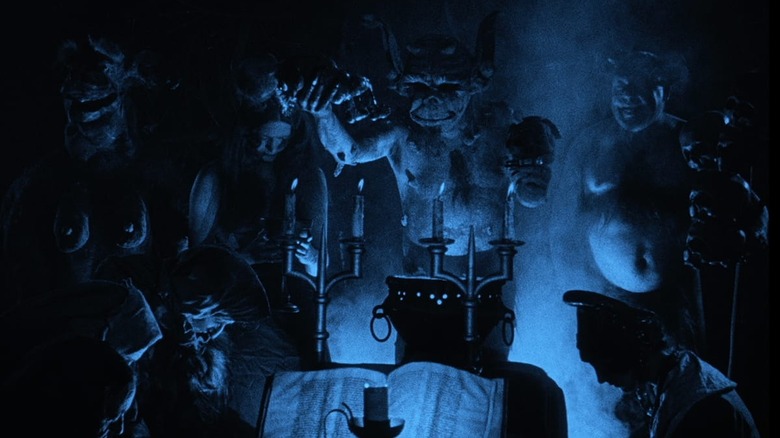
By turns academic, humorous, and disturbing, "Häxan" is something like a silent documentary that derives fiendish glee from its dramatic reenactments. It's been called an essay film, and the more intertitle-heavy parts do feel like the 1922 equivalent of a PowerPoint on witchcraft and medieval torture devices (via the "Malleus Maleficarum").
Written and directed by Benjamin Christensen, who receives literal butt kisses onscreen as the Devil, "Häxan" posited the forward-thinking idea that the persecutions of women as "witches" down through the ages arose out of fear and misunderstanding of natural phenomena like sleepwalking, kleptomania, and mass hysteria.
"Häxan" is Swedish for "The Witch," and in our interview with Robert Eggers, he revealed that this movie was one of the main influences on his own 2015 film, "The Witch." You can see it when "Häxan" delves into beliefs about witches preying on unchristened children, dancing naked in the Witches' Sabbath, and smearing their backs with flying ointment. Eggers said the film's close-ups also influenced "The Passion of Joan of Arc," which cast Joan (and by extension, other women burned at the stake) as a Christlike victim of priestly/patriarchal forces.
One scene in "Häxan" takes us into a witch's hovel, and it's as if we're visiting the prop department for the folk horror genre to come. Men carry in bundles of sticks ("The Wicker Man"), they unwrap a hand from one ("Blood on Satan's Claw"), there's a skull in the corner ("Hagazussa"), and a woman visits the witch, asking for a love potion ("The White Reindeer," "November"). We also hear of women being thrown into the water to test their guilt ("Witchfinder General").
Don't be shocked like Pixar fans when "Häxan" ends with the word "slut." It happens to mean "The End" in Swedish.
The White Reindeer (1952)

At 68 minutes, "The White Reindeer" is a short sleigh ride, but it's one you won't soon forget. It begins with a Finnish folk song about a woman "born a witch, evil in her belly." The film that unfolds from there bears the hallmarks of a nascent genre in which the sacred feminine would serve as a source of both desire and danger.
Mirjami Kuosmanen plays Pirita, who meets a reindeer herder and falls in love with him, only to find herself stuck waving goodbye and playing the neglected wife while he's off on his roundups in snowy Lapland (home of Santa Claus and pagan antler monuments). The unmistakable trappings of proto-folk horror begin to mount when Pirita consults a Sámi shaman. He's got a goat hanging out with him, and for his love potion to take effect, she needs to sacrifice the first living thing she encounters on her way home to the stone god.
The winning creature turns out to be a white reindeer fawn Pirita's husband had given her. Upon sacrificing it, she herself starts transforming into a reindeer, luring men to their deaths in Evil Valley.
Pirita is often described as a vampire or vampiric, but she can withstand sunlight and see herself in the mirror, and in fact, she rather enjoys admiring her fanged reflection. In the movie, the locals refer to her as "the white witch reindeer," which would seem to characterize her as something akin to a Navajo skin-walker (a witch that can morph into animals). With the way the full moon appears to trigger her transformations, she comes across as more of a were-reindeer, among the same class of therianthropes as werewolves and werecats. She might have made a better Mrs. Krampus instead.
Onibaba (1964)

The first image in "Onibaba," the title of which translates as "demon hag," is a windswept field of susuki (pampas grass), where the camera soon reveals a deep hole in the ground. Text informs us its "darkness has lasted since ancient times." By the end, it will come to signify the hole in the human heart, as a disfigured person leaps over it, shouting, "I'm a human being!"
During Japan's 14th-century period — a time of civil war when there are "two emperors" — an unnamed woman and her daughter-in-law are left to subsist as countryside bandits, stealing lives, weapons, and armor, and trading them for millet so they have something more to eat than dog meat. When a neighbor returns from the war with news of her son's death, the woman is forced to watch as he rejects her own advances and seduces her daughter-in-law.
Written and directed by Kaneto Shindo, "Onibaba" gives a few early intimations of horror, as the neighbor talks of strange things happening in Kyoto: horses giving birth to calves, and the sun rising black in the sky. The woman also tries to spook her daughter-in-law with stories of jigoku (hell), where a sinner like her might go for sleeping with her dead husband's friend. However, this isn't enough to stop the girl from sneaking out at night to the tune of jazzy taiko drumming and running through the reeds to meet her new lover, who insists "there is no Buddha" to mete out divine punishment.
The real horror comes when a samurai shows up one night wearing a demonic Hannya mask, which he refuses to take off. In Japanese Noh theater, the mask would evoke female jealousy, an emotion that does come into play in "Onibaba" — to gruesome results.
Witchfinder General (1968)

Directed by Michael Reeves, who died shortly after the film's release at the age of 25, "Witchfinder General" is the first of three movies that have come to be regarded as the Unholy Trinity of British folk horror (the other two being "Blood on Satan's Claw" and "The Wicker Man"). Released stateside as "The Conqueror Worm," it begins with a cold open that epitomizes the genre and terror of human history. A bucolic scene of sheep grazing and birds chirping is juxtaposed with a woman's wailing, as a mob of villagers leads her out to be hanged in the rolling green hills.
Like "Onibaba," this film is set during a civil war — the one in England. Vincent Price stars as Matthew Hopkins, a witch-hunter whose torture methods include pricking people's backs in search of Satan's mark and subjecting them to swimming tests. If they bleed and if they drown, they're not witches, but they still suffer and die. Patrick Wymark, who starred as The Judge in "Blood on Satan's Claw," cameos as Oliver Cromwell.
British film censors saw the "Witchfinder General" script as "a study in sadism." "Woodlands Dark and Days Bewitched" drew a connection between the scene where children roast potatoes in a woman's ashes and the opening scene of "The Wild Bunch," where kids watch ants devour a scorpion.
Here, the tropes of the genre were not yet fully formed, so the irrational forces of folk horror encroach on pockets of civilization, but they only hold partial reign. In fact, they themselves are threatened by agents of the military order. What's interesting about "Witchfinder General" is it shows soldiers fighting back against the evils of Hopkins and his partner, as if to restore the rightful social structure and overcome medieval brutality with modernity.
Wake In Fright (1971)
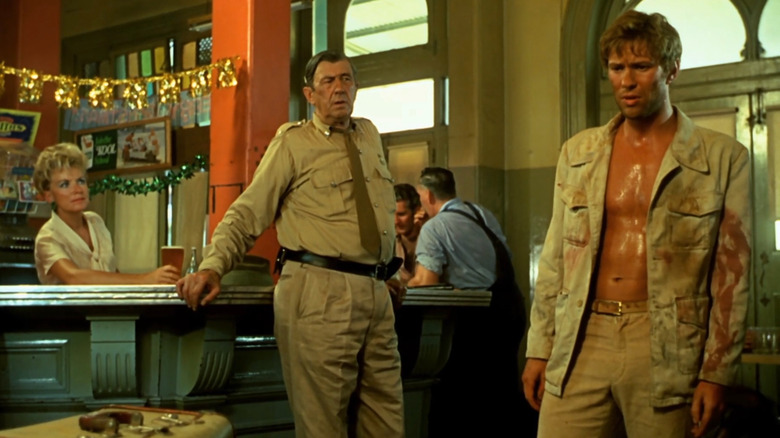
Folk horror films often begin with an establishing shot of the natural landscape. "Wake in Fright" goes all in on that, with the camera giving a 360-degree view of the Australian Outback, surrounding a desolate outpost that consists of only a schoolhouse, a hotel, and a single line of train tracks leading in and out of town.
Gary Bond stars as a schoolteacher whose financial bond with the government leaves him tethered to it as an indentured public servant. En route to Sydney for the holidays, he gets waylaid in the big little town of Bundanyabba. Here, Donald Pleasence and other men gather in bustling beer halls, get sucked into the gambling pit, and bond their fates to coin tosses.
Locals call it "the Yabba" and describe it as a "friendly place," but their "aggressive hospitality," as Bond's character terms it, is the type that has them asking, "New to the Yabba?" and "What about another beer?" before you've even sipped the one in your hand. Talking like a clever bloke breeds tension, and for some, the only way out of this Ozploitation land of the Lotus-eaters is by opting out of this life altogether.
Of all the films on this list, "Wake in Fright" is the one that most fits the "Wicker Man" mold of an outsider facing peril in a secluded community. Yet it departs from the focus on the feminine and instead plunges the viewer into a sun-baked masculine hell. ("All the little devils are proud" of it.)
Controversial for its footage of a real, nightmarish kangaroo hunt, "Wake in Fright" was once a lost film. John Scott's music keeps it bouncing along like an otherworldly excursion, employing instruments such as the ondes Martenot (which would later provide the spectral sounds of "Ghostbusters").
Picnic At Hanging Rock (1975)
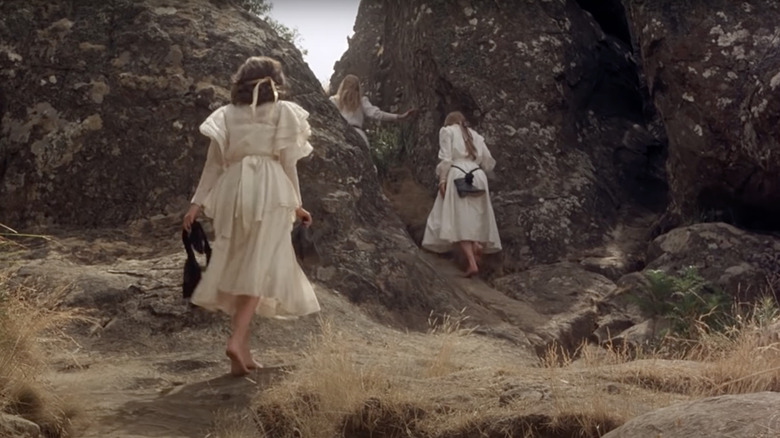
In "Picnic at Hanging Rock," British colonialism meets the untamed Aussie wild, and characters bring the folk horror home with them. Adapting Joan Lindsay's 1967 novel, Peter Weir — who would go on to direct such films as "Dead Poets Society" and "The Truman Show" — flips the genre script by having a group of schoolgirls and teachers take a field trip to the countryside. The group isn't physically stranded there like the protagonist in fellow Australian New Wave film "Wake in Fright," but some will go missing in the crevices of a rock formation, never to return, while others will remain mentally marooned there in the aftermath of the visit.
At the core of "Picnic at Hanging Rock" is the unsolved mystery of the disappearance of three girls and one teacher, and the destabilizing effect this has on their community as they are, to quote "Häxan," "confronted with something incomprehensible." The disappearance happens on Valentine's Day 1900, as if it's an affair of the heart, and its sheer inexplicability holds the potential to unravel even the stern headmistress' composure.
Hanging Rock is a place beyond the limits of human understanding, where watches stop ticking and time has no meaning. The rock provides an encounter with metaphysical chaos, with the girls stripping off their tight corsets and the social constraints that governed them at boarding school and entering the realm of the unanswerable and unknowable.
"Picnic at Hanging Rock" was an influence on "The Virgin Suicides" and HBO's "The Leftovers," the latter being a show where the song "Let the Mystery Be" played like a statement of theme over the season 2 opening credits. Like "Black Narcissus," this is a film where the strain between Nietzsche's Apollonian and Dionysian forces causes some to self-destruct.
November (2017)

You know how the commercial holiday of Halloween was born from the tradition of the spirits of the dead returning to their old homes on Earth? Well in "November," they wear white, and the whole village turns out to meet them as they make their ghostly procession in through the woods for All Souls Day.
It's a village that exists somewhere in the Venn diagram between Estonian mythology and offbeat Lynchian humor. Imagine if the Woodsman from the black-and-white episode of "Twin Peaks: The Return" had wandered off to Northern Europe and transformed into a pestilence of greed among 19th-century peasants.
Ghosts chewing on drumsticks are just one of the supernatural goings-on in Rainer Sarnet's film, which is based on a 2000 novel by Andrus Kivirähk. "November" begins with a kratt, a creature made of household tools and animal bones, wheeling across the ground, breaking down the barn door, stealing a cow, and then helicoptering away. Kratts, which sometimes take other eccentric forms, like that of a poetic snowman, gain sentience only after their master has gone out to the crossroads at night to make a blood pact with the devil. He's in this, too, as a rather buffoonish character who doesn't take kindly to being tricked.
"November" has it all. There's also a werewolf and a good old-fashioned fairytale love triangle at the heart of it. "The plague" can be a woman who needs to cross the swamp, or it can be a goat that gets confused and thinks people have two rear-ends when they put their pants on their head. Mart Taniel's Tribeca-winning cinematography grounds the weirdness in exquisite images, even as the stark setting upends folk horror conventions and leaves one spirit asking, "What flowers will you pick in November?"
Luz: The Flower Of Evil (2019)

At a time when too many movies and TV shows are draped in darkness, to the point where the viewer needs to adjust the brightness settings on their screen, "Luz: The Flower of Evil" makes an immediate impression with its vibrant, oversaturated colors. Juxtaposing rainbows, religion, and surreal mystical qualities with yet another lurking goat and a family in an isolated cabin, this Spanish-language film could be described as Alejandro Jodorowsky by way of "The Witch." There's also a drift toward Terrence Malick stylings in its reliance on whispery voice-overs and magic-hour vistas.
A hypocritical patriarch known only as El Señor lives a cultish life with his three daughters, only one of whom is related to him by blood. Like a televangelist-turned-mountain man, he believes a tape deck holds the devil's music and tends to make promises about the second coming. In this case, it's the Jesus-reincarnated-as-a-child type, with the mute kid acting as a blank canvas for projected beliefs.
The girls are at their most angelic, almost sirenlike, when bathing below a waterfall. But at the center of the movie is a fixation on the idea of good confused with evil and the coexistence or "cohabitation" of the two forces within people.
In terms of what happens onscreen, "Luz: The Flower of Evil" is a strange, rather oblique film: often meditative, occasionally eventful. Colombian writer-director Juan Diego Escobar Alzate prefers to use dialogue as the delivery system for his familiar folk horror themes, as if to simulate sermons through narration. Femininity and nature overthrow masculine oppression and its behavioral constructs. This is an international co-production; it has 10 different countries behind it, though it premiered in Spain at the Sitges Fantastic Film Festival before debuting on Shudder in 2020.
The Medium (2021)

Writer-director Na Hong-jin threaded a knotty nightmare with "The Wailing," a film that danced and drummed itself into a crescendo with an unforgettable shaman exorcism scene that proved South Korean villages were prime for folk horror. "The Medium" began life as a potential sequel anchored to that film's shaman, before Na decided to disconnect it from "The Wailing" and uproot the action to somewhere outside Korea, "a place where it rains a lot with a dense forest."
Acting as co-producer, he handed the original story off to director Banjong Pisanthanakun and other writers, who settled on the misty mountains and rice fields of Isan, a region in Northeast Thailand. "The Medium" starts out as a documentary about Nim (Sawanee Utoomma), whose family has spent generations channeling the ancestral goddess Ba Yan as shamans and mediums. Nim's sister was in line to be the next one, but she rejected her animistic birthright and converted to Christianity.
When Nim's adult niece, Mink (Narilya Gulmongkolpech), begins sending off bad vibes, hanging protective turmeric in her closet, picking fights on kiddie slides, and acting out in transgressive ways, Nim comes to believe she's possessed, perhaps because Ba Yan wants her as a vessel or because her dead brother and a family curse on her father's side have come back to haunt her.
"The Medium" isn't as deep or well-executed as "The Wailing." Its night-vision, found-footage, hold-the-camera-while-dying aesthetic sometimes feels a little schlocky, as if "Paranormal Activity" had spawned another Asian sidequel like "Tokyo Night." And whereas dog meat only received a passing mention in "Onibaba," here it's present in more than one way. However, the film has some creepy moments before it descends into third-act pandemonium, and the selling points here are the regional actors and setting.
Lamb (2021)

Between "Lamb" and "You Won't Be Alone," folk horror could have a new reigning May Queen in Noomi Rapace. But she's not the one wearing a crown of flowers in this movie.
"Lamb" begins with a Christmas night prologue in which horses literally turn tail and run as the POV of some rough beast slouches toward a barn instead of Bethlehem. We're on a remote Icelandic farm, where a childless married couple lives. The wife is named María, and the husband does carpentry, for good measure. One of their goats soon gives birth to an unnatural creature, leading them into an absurd living arrangement that sees María's brother-in-law speaking for the viewer, asking, "What the f*** is this?"
Co-written by Sjón ("The Northman") and Valdimar Jóhannsson in his feature-length directorial debut, "Lamb" is filled with quiet spaces. It's not until 10 minutes into the movie that the characters really say anything. Their first meal conversation — about the latest news in theoretical time travel — is a good example of dialogue that is more about what's left unsaid. It leaves the audience to surmise that María has some sort of regret, a thing she wishes she could go back and change.
Outside forces seem intent on disrupting her ephemeral happiness and returning her to a state of unresolved grief. When you steal from nature, it may demand bloody retribution, and when you watch an A24 film, it may contain sheep or billy goats.
"Lamb" is mostly a three-hander, similar to "Onibaba." It just goes to show that not every slice of folk horror need be about a pastoral community overpowering the individual. Sometimes the genre is just about a person coming up against the larger elemental forces that such communities represent.
Read this next: The 13 Best Movies About The Devil Ranked
The post Folk Horror World Tour: 10 International Titles from the Last 100 Years appeared first on /Film.
Why You Need To Read Neil Gaiman's The Sandman Before The Netflix Series

If there's one title you're sure to find on just about every list of the all-time best comic books out there ... it's "Watchmen," because best-of lists tend to be kind of predictable and boring that way (at least the non-chaotic ones are). But just as there's value in reading Alan Moore and Dave Gibbons' famous deconstruction of the superhero genre anyway, you should also seek out the other graphic novel we nerds love to go on and on about: Neil Gaiman's original run of "The Sandman."
Crafted by Gaiman in collaboration with a variety of talented comic book artists from 1989 to 1996, "The Sandman" is truly as layered and lyrical an attempt to grapple with the enormous complexities of existence, love, death, and dreams as any other graphic novel out there. Of course, if you're reading this, there's also a fair chance you've been told as much so many times that you're either scared to read it now for fear it can't possibly live up to all the hype, never had the time to make your way through Gaiman's tome (which spans 75 issues collected in 10 volumes), or gave up after being underwhelmed by its earlier chapters. Plus, with the live-action TV adaptation headed to Netflix, why bother at this stage?
These are all valid points. "The Sandman" is clunky starting out, and there's a lot of it to get through — and who the heck has that kind of leisure time these days other than the Endless, if even them? Still, as is usually the case with Gaiman's work (and, as Death might tell you, life itself), "The Sandman" is more about the journey than the destination. And the journey of reading Gaiman's daunting, dazzling, boundlessly imaginative saga is as unique to the comic book medium as they come.
Humble Beginnings
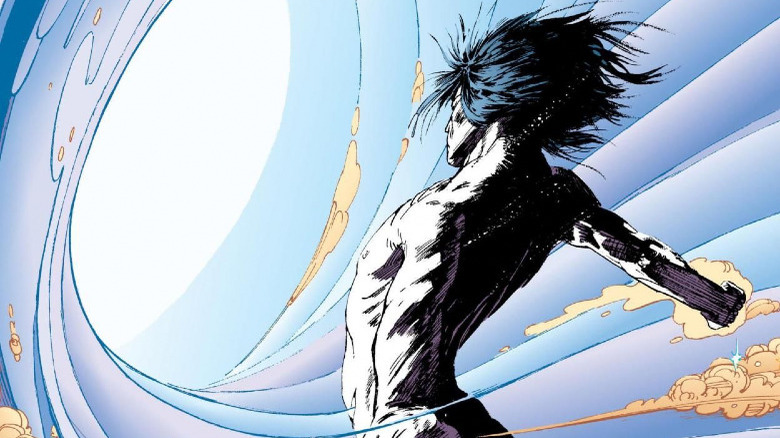
"The Sandman" centers on Dream, the personification of dreams and a shape-shifting entity who's gone by many other names across eternity, most notably Morpheus. To quote Neil Gaiman's proposal for the comics from 1987 (which is featured in "The Absolute Sandman, Volume 1"):
He is not alive in the way we would understand living, nor could he ever die in the way we understand death. He exists because, since the first living being existed in the universe, there have been dreams, and in some obscure way, someone was needed to represent, personify, and control them.
Dream's real-world origins are, admittedly, less poetic. It began with Gaiman writing a treatment to reboot a 1970s DC Comics property called "The Sandman." Co-created by the legendary Jack Kirby, the series centers on the titular superhero, who battles monsters intent on attacking children through their nightmares. To his pleasant surprise, however, Gaiman would instead get the go-ahead to pen a brand-new comic under the same title.
For as different as these two versions of "The Sandman" would prove to be with time, Dream was not unlike a superhero himself starting out. Case in point, the first volume of "The Sandman" comics, "Preludes & Nocturnes," begins with Dream escaping captivity after being held captive for decades by a group of occultists who mistook him for his sister, Death. Upon finding that his kingdom, the Dreaming, has fallen into ruin in his absence, Dream sets out on a quest to recover three totems that are essential to his power in the hopes of rebuilding his domain. When you get down to the heart of the story, it's as basic a hero's journey as they come (albeit brought to life with Gaiman's elegant prose, coupled with his rich sense of horror and dark, disturbing fantasy).
Death And Nightmares
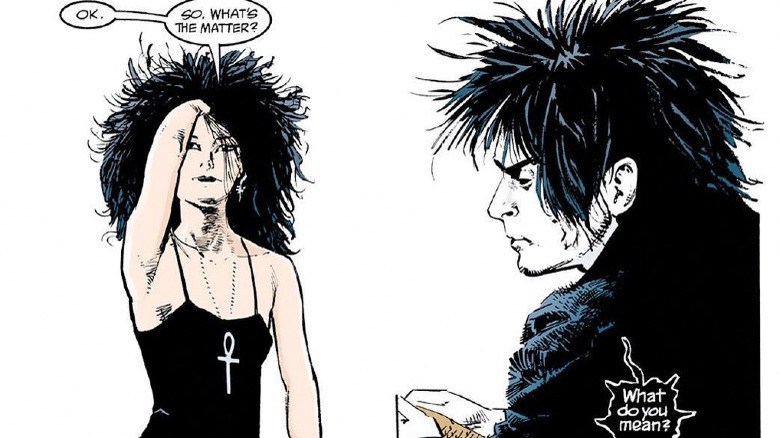
Reading them now, you get the sense that Neil Gaiman hadn't entirely figured out what he was aiming for with the earliest issues of "The Sandman," much less what his comics are about in a larger sense. Besides going a little overboard on the quasi-edgelord horror, these are the issues that play the most with the idea of Dream occupying the same reality as other major DC characters, to often clumsy results (save for John Constantine, who's gotten a fitting "upgrade" in "The Sandman" TV show). It's why there's an almost meta quality to the very last issue of "Preludes & Nocturnes," an epilogue in which Death shows up for the first time and pulls her brother out of the funk he's been in since completing his quest to regain his full powers. She pushes him to find a new purpose and even chucks a loaf of bread at the gloomy oaf's head for good measure.
Gaiman, like Dream, took her advice and ramped up the world-building with the next set of issues (collected in "The Doll's House"), introducing the other members of Dream's ageless family (the Endless) along with key characters who would show up again and again in future stories (Queen Nada, Rose Walker, Hob Gadling), and a rather gnarly living nightmare in the form of the Corinthian (watch out for his eyes!). This is also where Dream's personal odyssey evolves from the material (collecting MacGuffins to drive the plot) to the existential, as he takes his first steps towards atoning for the many mistakes he's made across eternity while pondering that question all us mortals have to wrestle with at some point: Can I change for the better? In doing so, "The Sandman" goes from being full of promise to fully realizing its potential.
What Dreams May Come
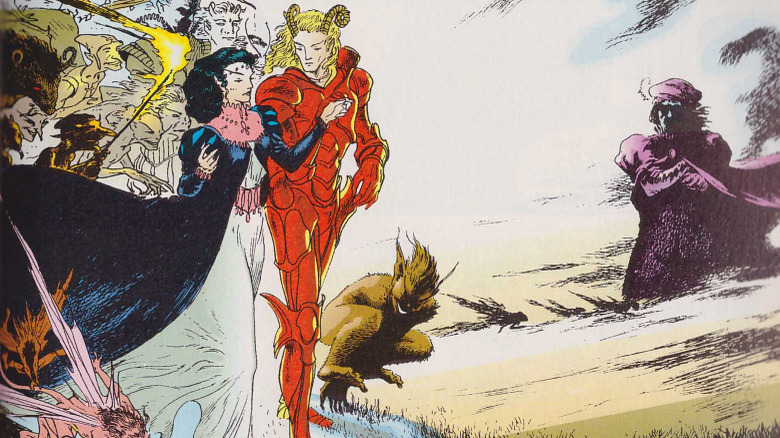
"Dream Country," the third volume of "The Sandman," finds Neil Gaiman evolving the very narrative fabric of his comic book series. Comprised of four short stories, these issues deconstruct the basic idea of what a "dream" even is and how the stories we tell about ourselves and our past can become more "real" than whatever actually happened. This, in turn, is where Gaiman begins to weave real-world mythologies into the tapestry of "The Sandman," uncovering new meaning in elements of classic Greek tragedy, transforming Element Girl from obscure DC superhero to a heart-breaking embodiment of the human experience, and even going so far as to make William Shakespeare a vital player in the saga of Dream.
Gaiman's ambitions only grow from there. Later issues of "The Sandman" forgo a linear path in favor of a winding yet pointed trajectory. They also embrace ever-more-challenging subject matter, tackling what were, for their time, landmark queer stories and enriching what once seemed like trivial plot points and characters from issues past. The various trials and tribulations of Dream's dysfunctional family (or, as Gaiman might put it, "family") thusly become potent metaphors for our own earthly troubles. Themes about the fluidity of gender and identity and the never-ending struggle to find meaning in a finite universe only take on greater significance and poignance thanks to the presence of the Endless and the residents of The Dreaming.
The further along you delve into "The Sandman," the more the series begins to take on a distinct shape narratively. Every tangent or standalone subplot comes back around at some point, right down to those pesky DC Comics cameos from early on. It why the experience of reading Gaiman's comics as a whole is far more rewarding than trying to cherry-pick the best sections.
Elusive Dreams
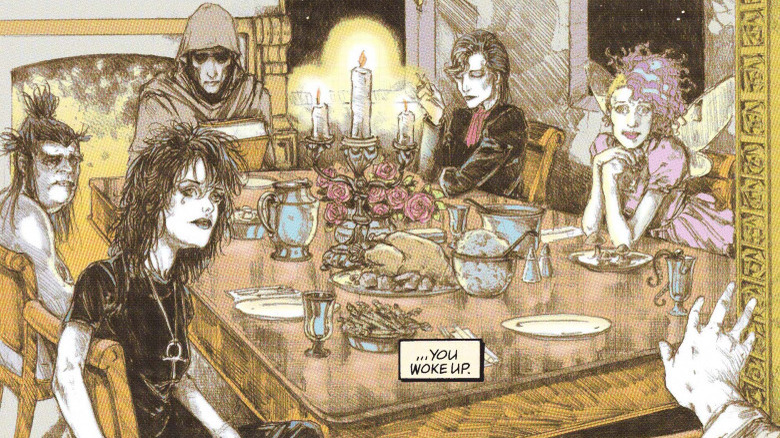
Just as there are things a TV show can do that a comic book cannot (like turn your favorite characters into figures made of flesh and blood), Neil Gaiman is deliberate in the way he uses the comics medium to serve the stories of "The Sandman." The idea that Dream is never the same thing to any two living beings, and all which that implies, comes across beautifully over the course of the comics as different artists create their personal visions of Dream, the Endless, and the very act of Dreaming. The look and shape of these things ebb and flow depending on who's drawing them, with no two interpretations exactly alike. It's a quality that simply cannot be fully replicated or carried over into a live-action format, even with the digital tools available today.
This then asks a big question: Can the "Sandman" TV show ever hope (Dream?) of reaching and perhaps even surpassing the heights of its source material, flaws and all? For all the advantages it has (namely, being able to modernize aspects of the comics that haven't aged so well), that's quite the tall order. Gaiman's graphic novels grow ever more complex and meticulous in their design over time, in ways that parallel the trajectory of revered TV series like "The Wire." If that's not incentive enough to give "The Sandman" comics a shot however the TV show fares, then, well, like Destruction, I take leave of my post.
"The Sandman" TV series will premiere on Netflix on August 5, 2022. Gaiman's comic books are available to purchase from a variety of outlets, and might even be available to borrow from your local library. That's how I first read them many years ago, and I'd like to think Gaiman would be pleased to know that.
Read this next: The 15 Best Batman: The Animated Series Episodes
The post Why You Need to Read Neil Gaiman's The Sandman Before the Netflix Series appeared first on /Film.
Starfield brings back The Elder Scrolls: Daggerfall’s mortgages

Bethesda’s open-world, space RPG Starfield will allow you to get a mortgage, harking back to the debt-ridden days of The Elder Scrolls: Daggerfall – or more recently, Animal Crossing.
Summer Games Fest has given us a lot of tantalising new details about Starfield. It will have 1000 planets you can freely explore. You can customise your ship and have dogfights. There’s a photo mode, to capture the universe in all its glory. But what Bethesda didn’t mention – but that you can spot, if you pay eagle-eyed attention to the trailer for the game’s character creation screen – is that when you select your background trait, one of the options, ‘starter home’, lumps you with a 50,000 credit mortgage. Wow! Space debt!
Of course, you get something nice for your money – 'a small house on a peaceful little moon', according to the in-game description. But you’ll owe it all to the frankly sinister-sounding ‘GalBank’. We can only speculate what happens if you don’t make your payments, although ‘Space Bank Manager’ does sound like it would make for a pretty good boss fight.
RELATED LINKS: Starfield release date, Best space games, Elder Scrolls 6 release date

